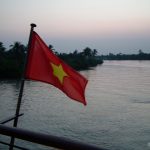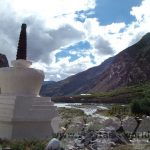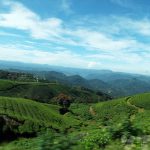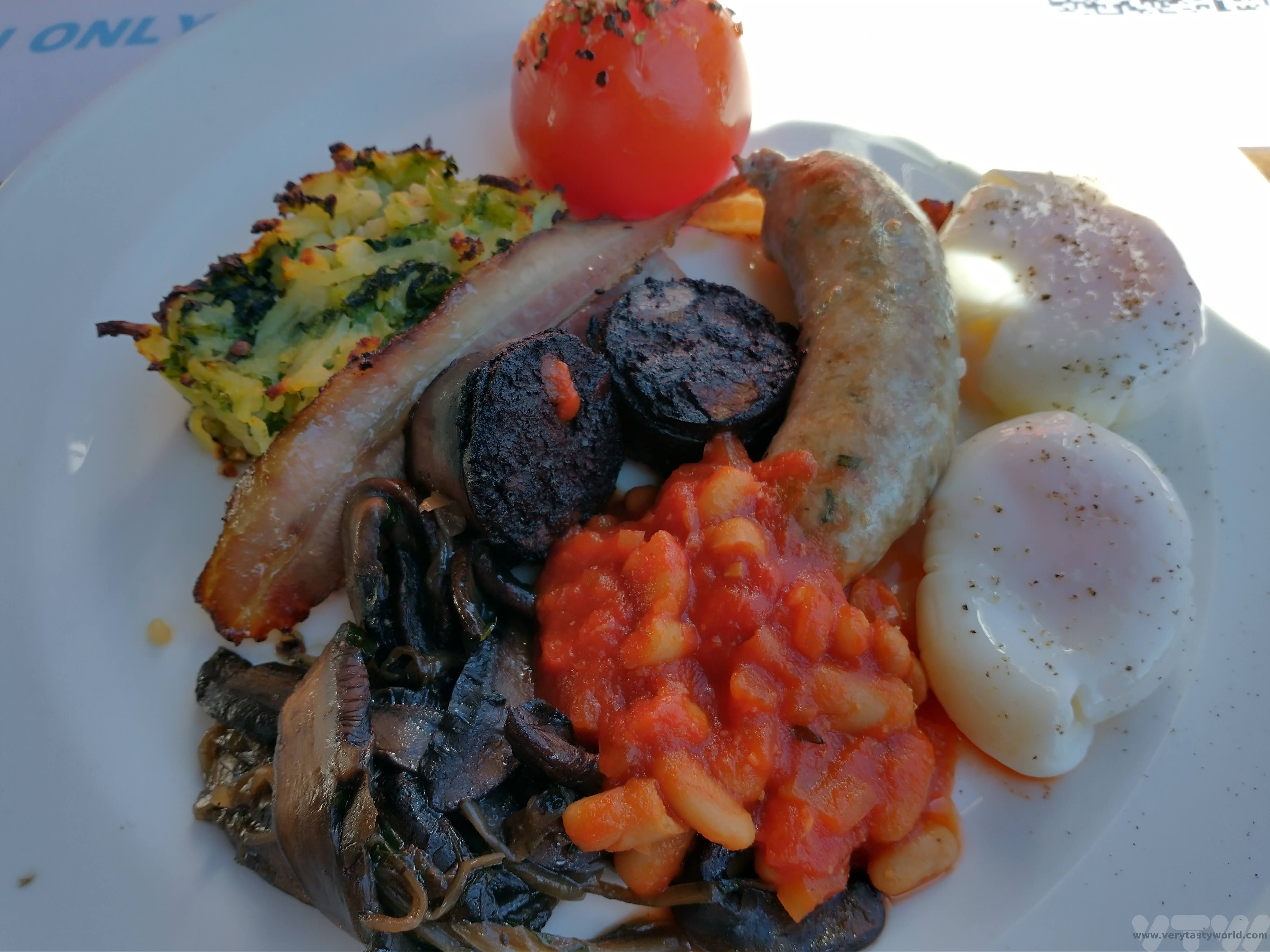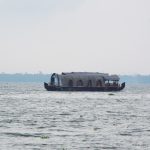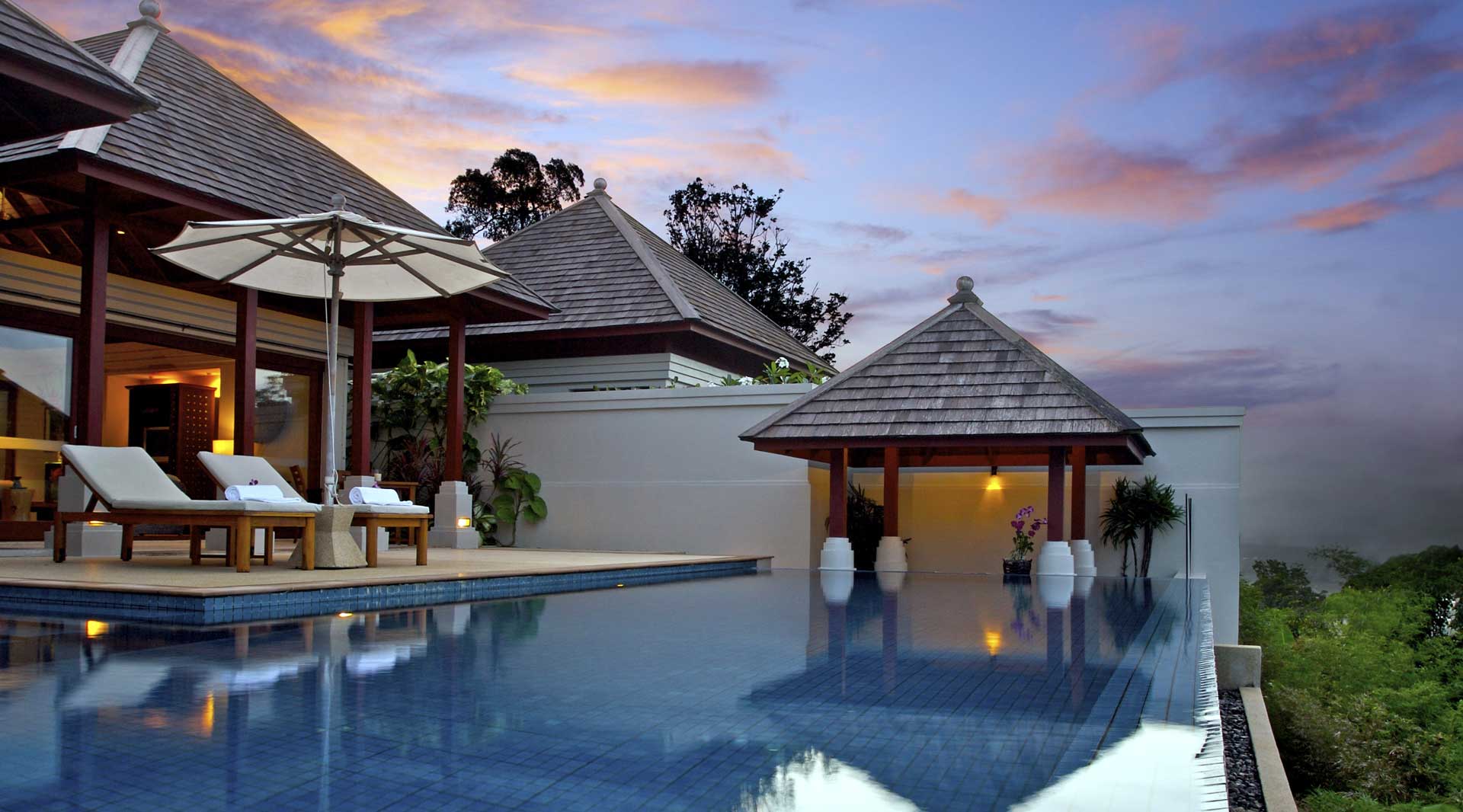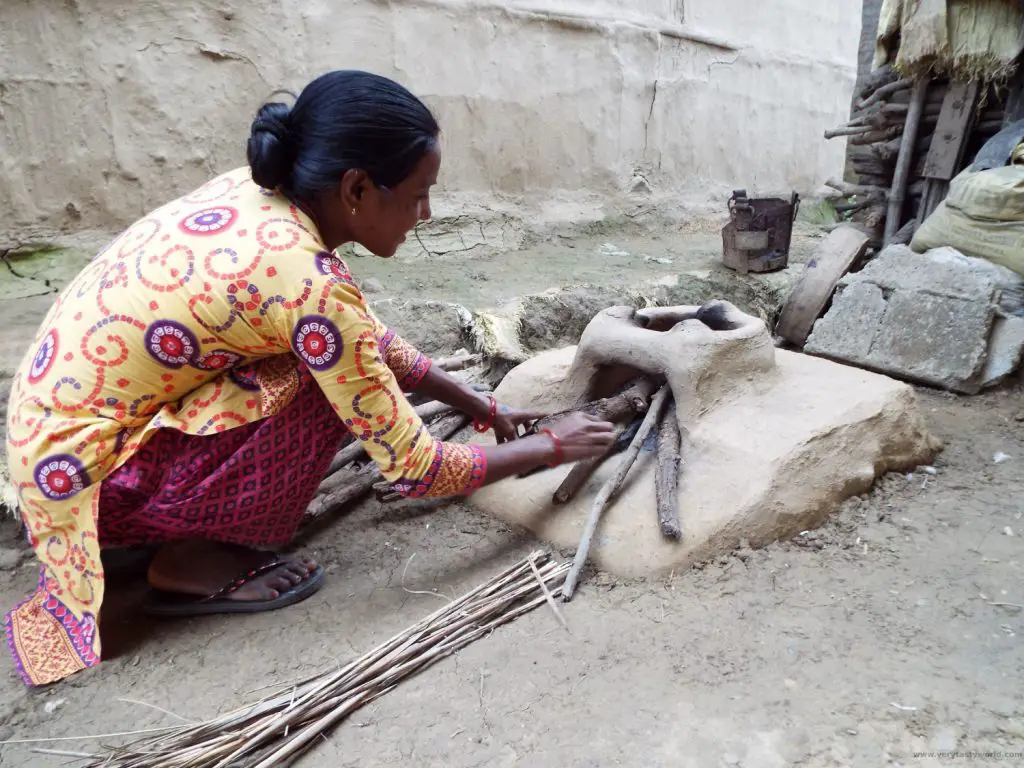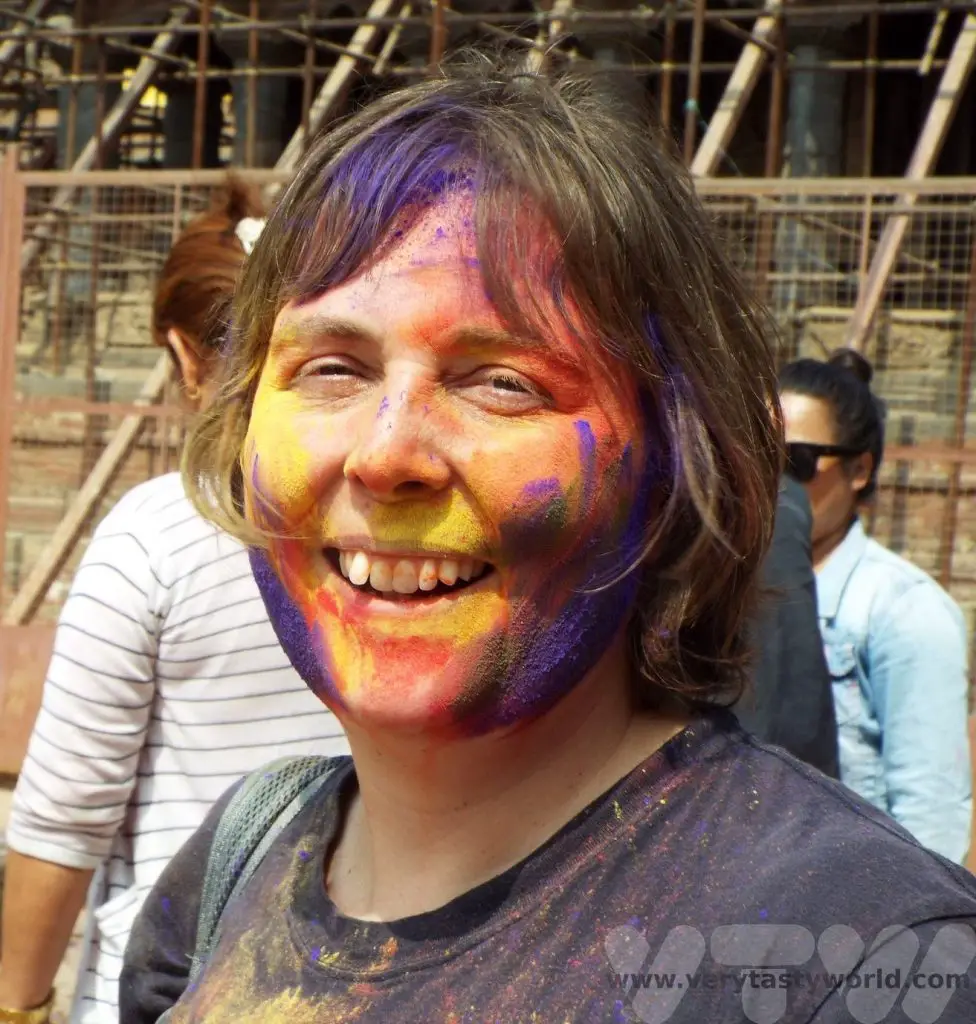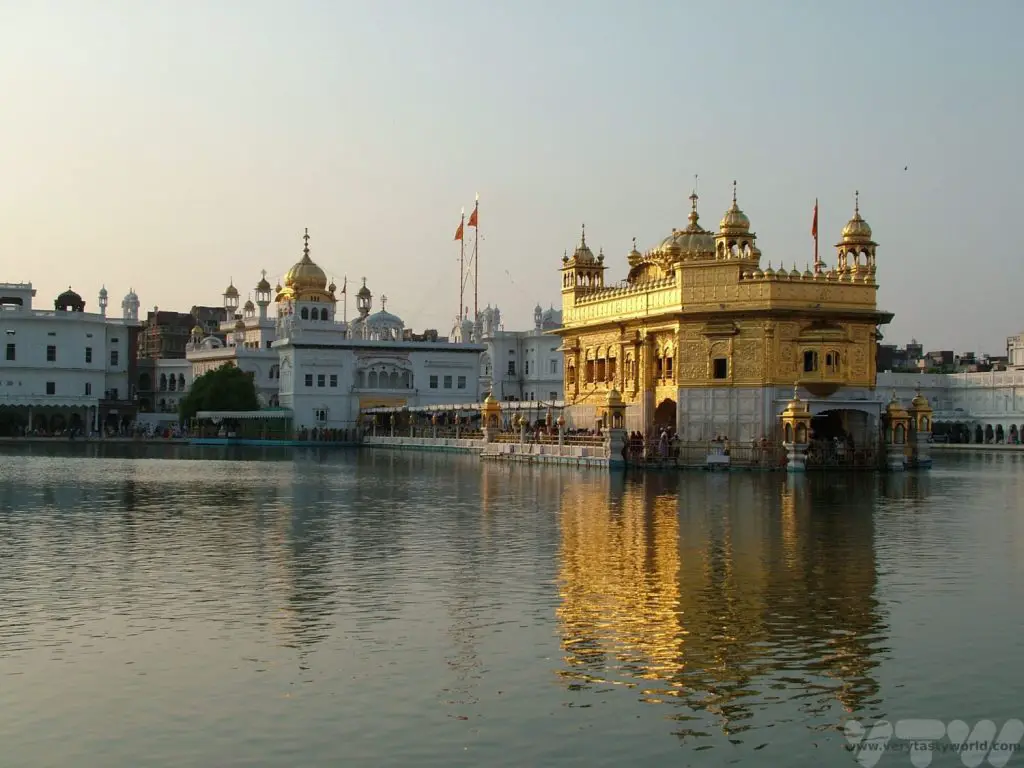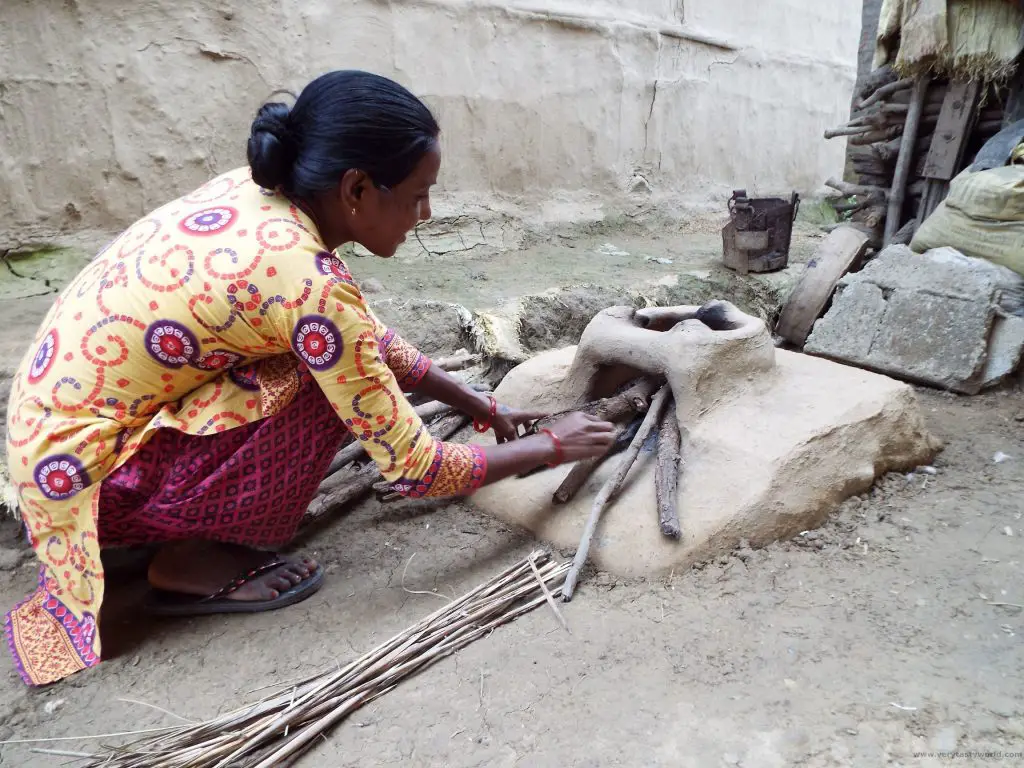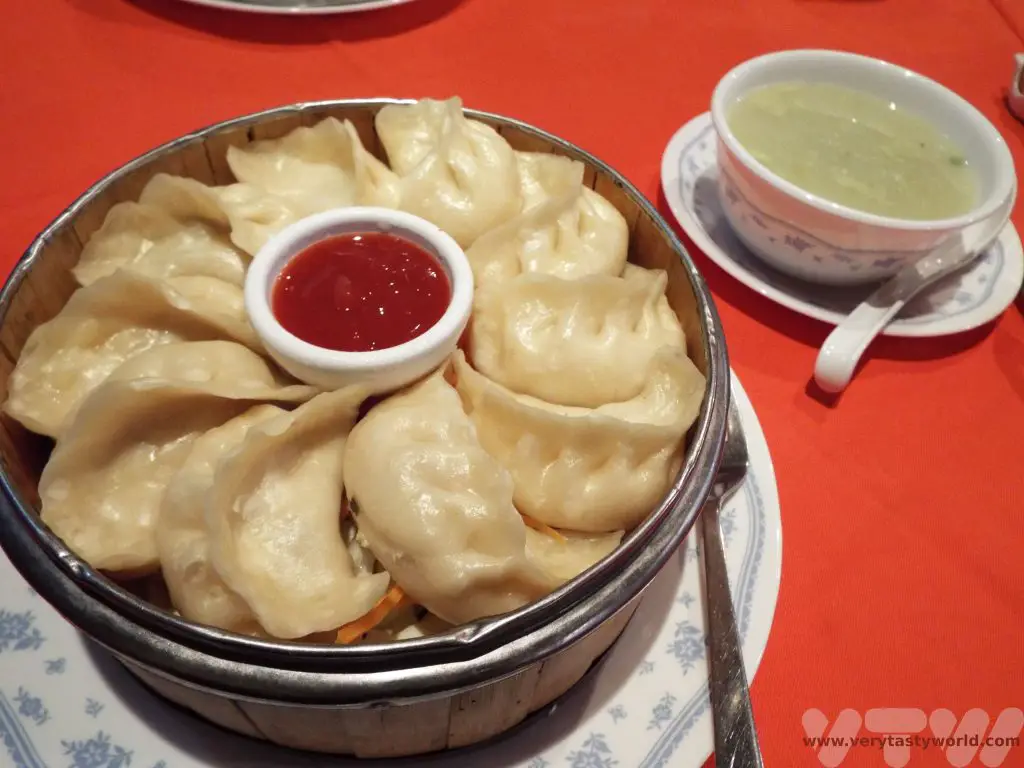A Guide To The Bhutan Tiger’s Nest Trek
One of the highlights of a visit to the delightful Himalayan kingdom of Bhutan is a hike to the Tiger’s Nest, a monastery that clings dramatically to a cliff some 900m above the Paro Valley. Here is our guide for what to expect on the Bhutan Tiger’s Nest trek, a hike which is, quite literally, breathtaking.
Travelling in Bhutan is a very different experience to most other journeys. It is standard practice to visit Bhutan with a driver and guide accompanying you, as independent travel is not encouraged in this country. Our lovely guide Dawa accompanied us to the Tiger’s Nest.
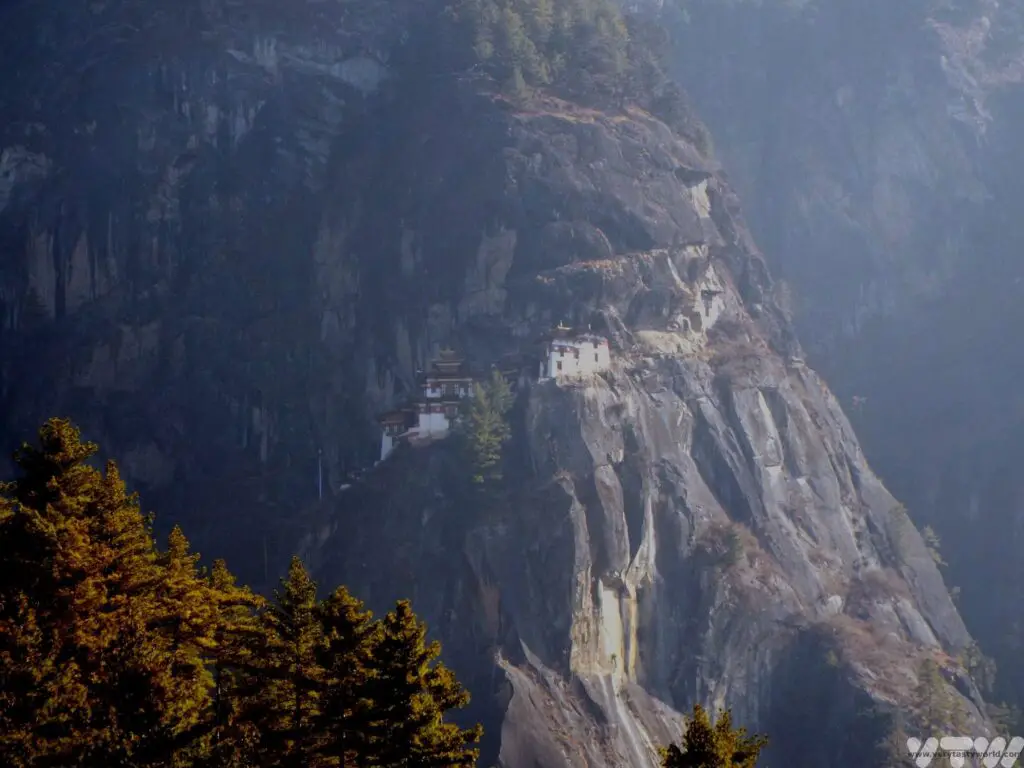
Paro is probably the flattest region that we visited within mountainous Bhutan and is the city where the country’s international airport is located. The flight in, as the plane weaves its way through the spectacular Himalayas, is an experience in itself. We flew from Nepal, passing Mount Everest on the way. (Top tip – ask for seats on the left side of the plane when checking in at Kathmandu airport.) But the landscape changes dramatically just outside the city as the mountains tower above the river, Paro Chu. Tiger’s Nest is located around 10km north of Paro.
The Legend of the Tiger’s Nest
Tiger’s Nest, known as Paro Taktsang, became a holy place in the 9th century. There is a legend that Guru Rinpoche (Padmasambhava) flew to this location from Singye Dzong on the back of a tigress and meditated inside the cave on the mountainside for several years. Guru Rinpoche brought Buddhism to Bhutan and is considered to be the most important saint in the country. There is a different legend that the wife of an emperor transformed into a tigress and carried Rinpoche on her back from Tibet. It is thought that the place became holy following the Guru’s meditation when he emerged in eight incarnated forms. A monastery was constructed around the caves in 1692.
Bhutan Tiger’s Nest Trek – The Overall Route
Visiting the Tiger’s Nest is one of the most popular activities in the region. We arrived early in order to get ahead of the crowds. When you arrive you will see that there are a number of mules available for hire. They can take you halfway up the route to the cafeteria, you cannot complete the whole route riding a mule. We don’t like using animals to transport us and we love walking, so chose not to ride. Also we wanted the satisfaction of hiking the whole way!
The photo – taken for posterity from the car park – shows the Tiger’s Nest. Can you see it?
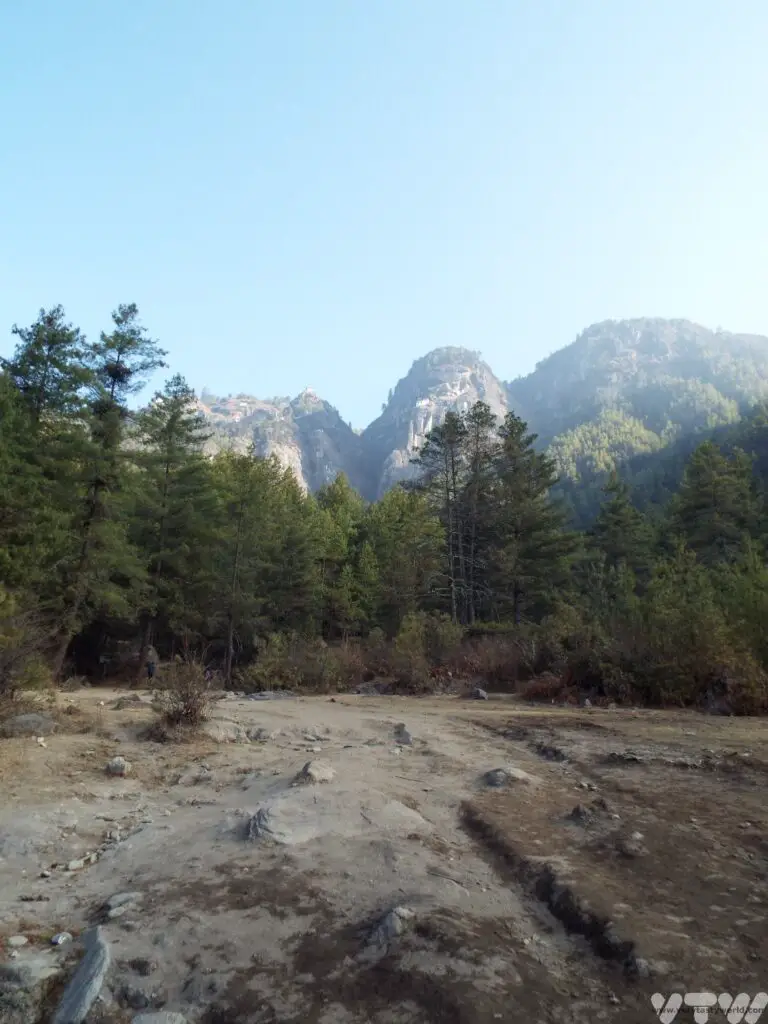
Here’s a photo with an arrow to show that it is waaaaaaay in the distance, clinging to the cliff face. It looked like a long way up. It was. But don’t worry, the route isn’t as direct as it looks – no actual climbing required!
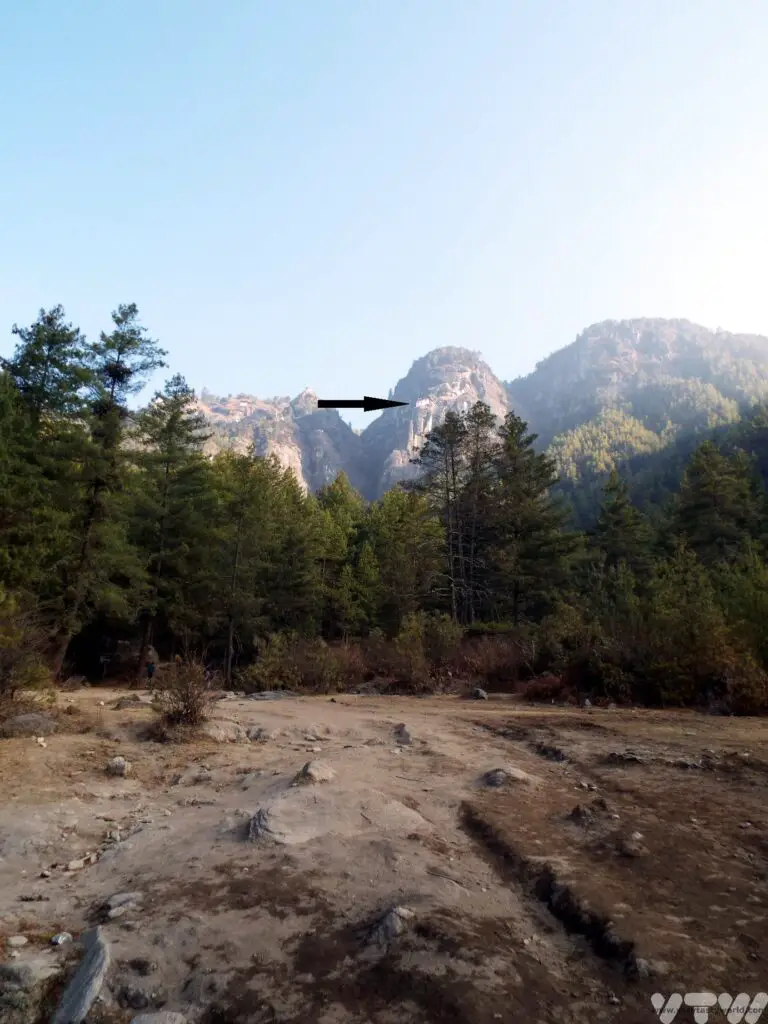
Walk To The Halfway Point
The majority of the Tiger’s Nest trek takes place along the adjacent hillside. The walk up to the halfway point isn’t particularly steep – just a consistent upward incline through the woodland on a sandy, occasionally rocky path.
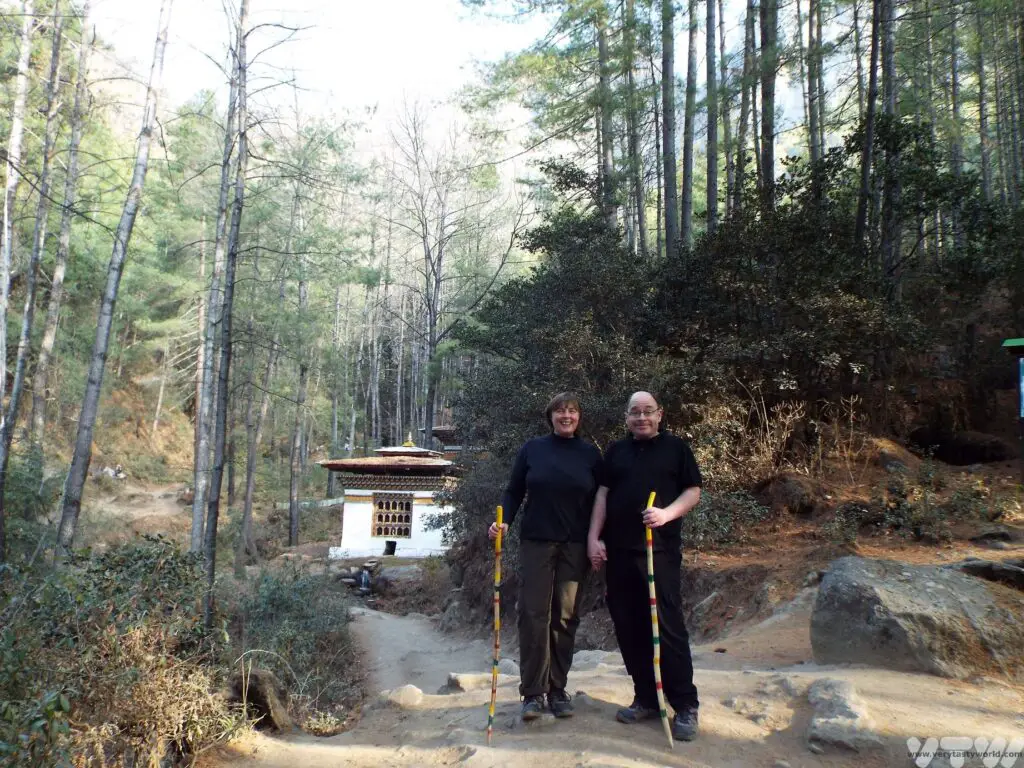
There is a cafeteria at the halfway point where you can get refreshments and use the bathroom if needed. This is as far as the mules will carry anyone. It will also be the last opportunity to use the toilet until you return to this area. The photo below shows the cafeteria from the top viewpoint.
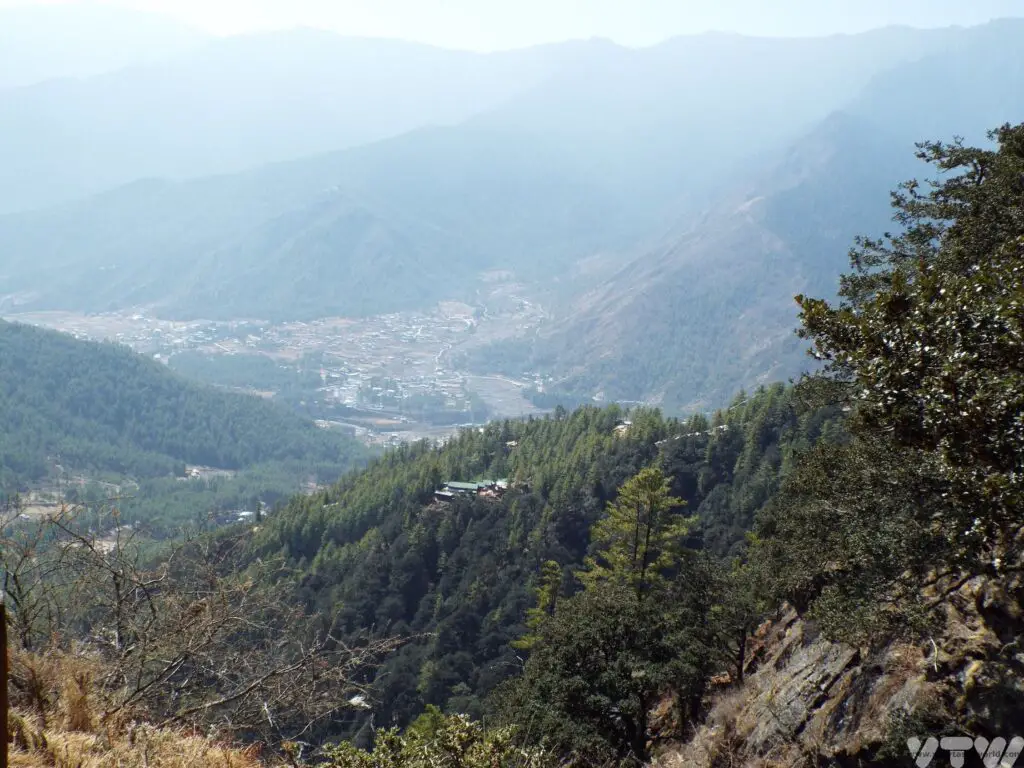
There is a good view of the Tiger’s Nest from the halfway point.
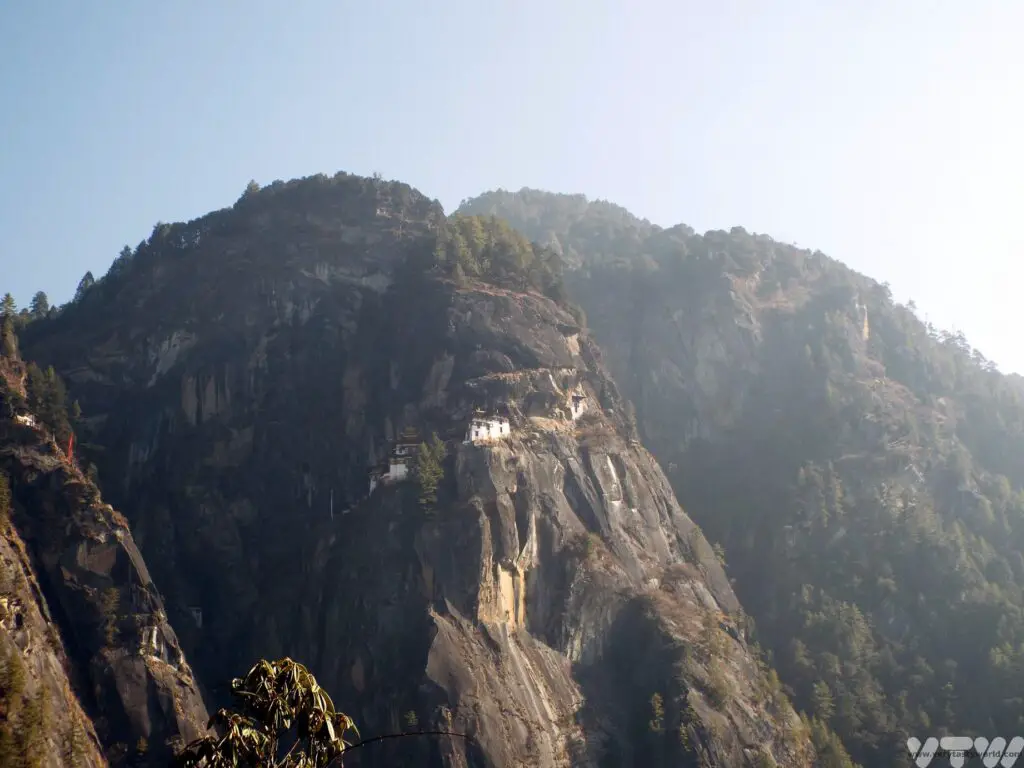
Continue To The Viewpoint
Continuing the trek you climb higher and higher until you reach the splendid viewpoint, an essential photo stop which offers your first close-up glimpse of the monastery buildings. It’s at approximately the same elevation as the Tiger’s Nest but it is located across the valley which needs to be traversed.
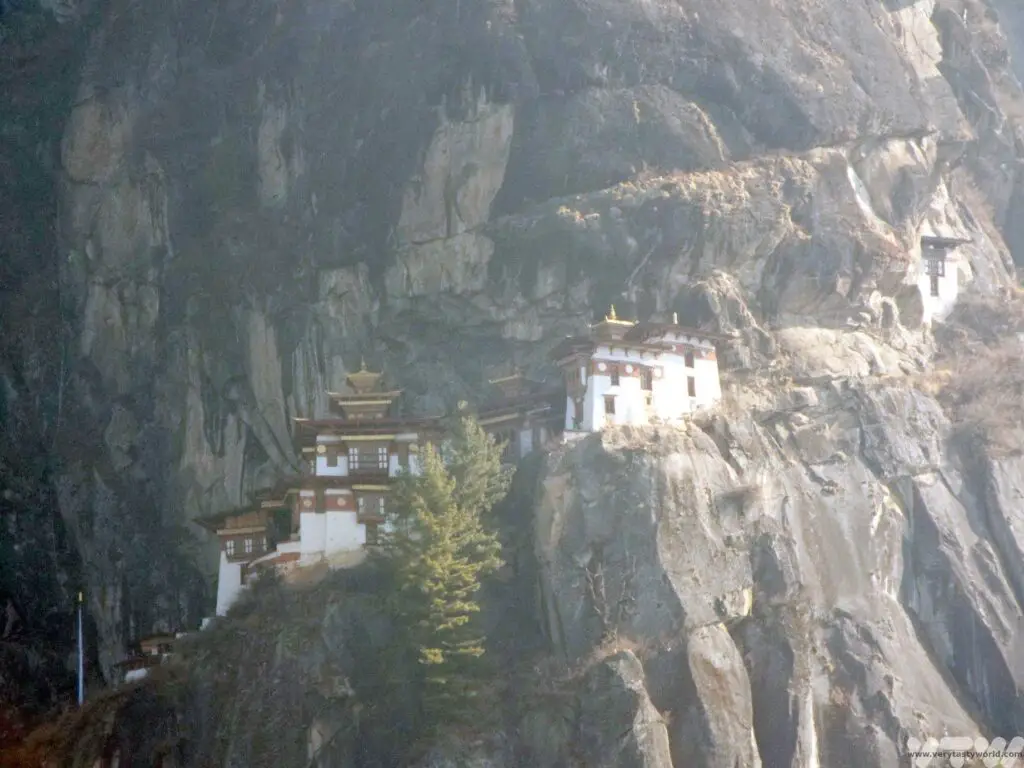
The Final Stretch (aka the Tricky Bit)
When you reach the viewpoint you think you are almost there but the most difficult part of the trek is yet to come. You need to cross the valley to reach the monastery on the other side. You descend slightly along the cliff path, which is easy enough.
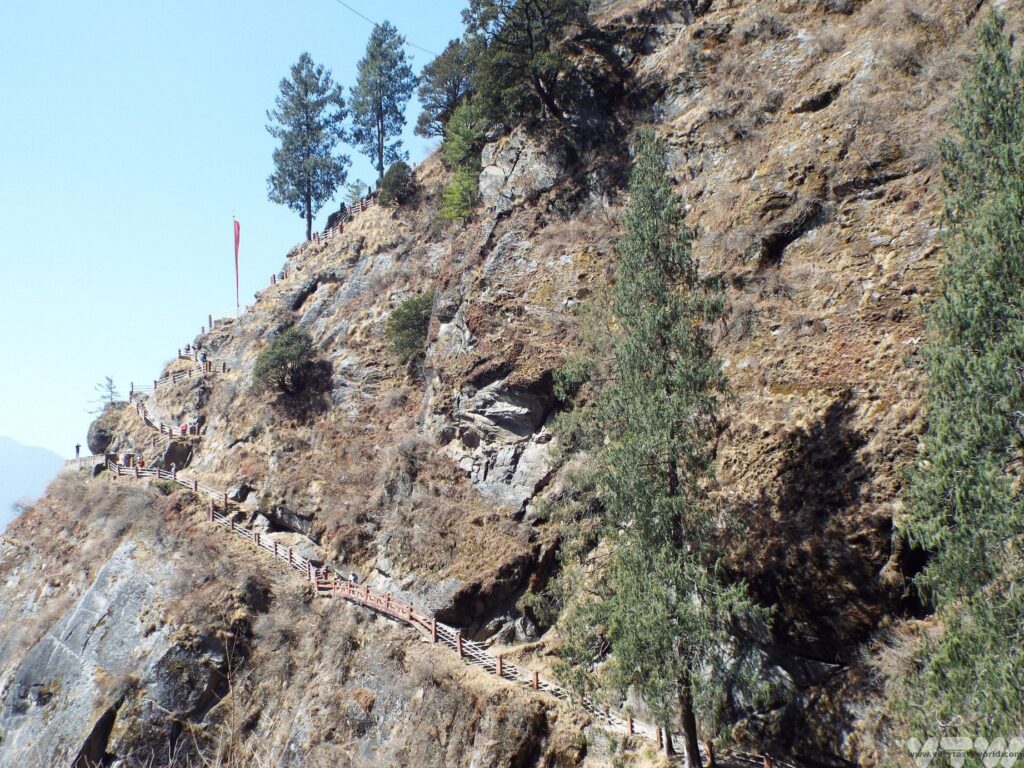
But then need to cross a narrow section with a waterfall on the cliff-side in order to reach the next mountainside. It’s not hugely difficult but can be a little slippery and isn’t ideal if you’re not keen on heights as there’s a fair old drop to the valley below.
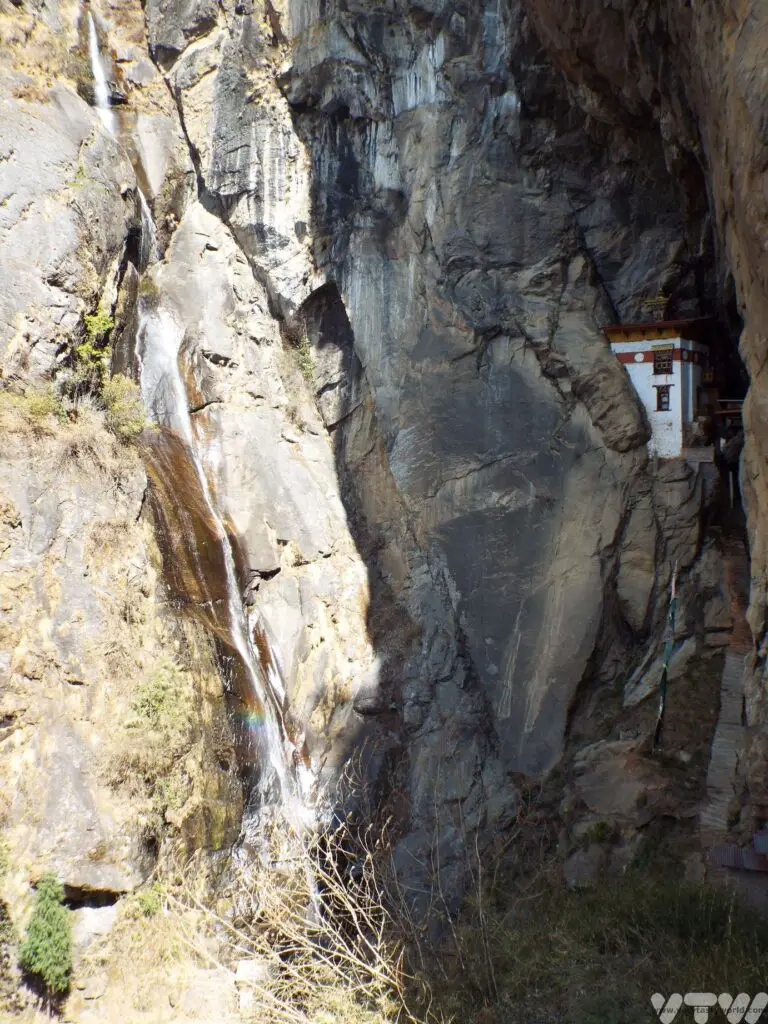
Then it’s a walk up the other side, largely on steps, to the monastery itself.
Entering the Monastery
Once you have reached the monastery entrance you might think you have reached the top. But there are a lot of stairs inside the monastery itself. We trekked up alongside a random fellow traveller who made it to the entrance but was just too tired to explore it! So save a bit of stamina. Shoes must be removed in order to visit the various rooms within the temple.
This is a working monastery so photography is not allowed. The temple is comprised of four main buildings. Padmasmabhava’s cave – the first one he entered riding the tiger, is called Tholu Phuk and the cave where he meditated is Pel Phuk. Steps have been cut into the rock and there are bridges to cross in order to reach particular rooms.
Bhutan Tiger’s Nest Trek – The Route Down
You return via the exact same route. While the upward journey is hard on your lungs, the downward journey is hard on the knees. Again, although the descent will be quicker, take it easy and don’t rush.
Information About The Hike
When Is The Best Time to Attempt the Hike?
We visited Bhutan in March which was the low season. As it was early spring the weather was a little chilly at times but that was absolutely perfect for walking in. It also meant that the route was less crowded than in the high season (April, May and September to November). It is possible to visit Tiger’s Nest all year round but beware that the monsoon arrives in Bhutan during the summer so trekking wouldn’t be much fun. And we wouldn’t want to attempt the waterfall crossing section on a slippery path in the rain.
Do You Need to Be Fit?
The walk should be fine for anyone of average fitness. The total distance covered is around 6km. The most challenging element is that you are trekking at altitude – the hike will take you to over 3000m above sea level – and this could well knock the breath out of you. There is a lot less oxygen available at these dizzying heights. The elevation gained is around 500m from the car park to the monastery. Some people do struggle with the altitude and acute mountain sickness is a serious condition. Follow your guide’s instructions and do let them know if you are feeling unwell.
We actually did our trek at the end of our trip to Bhutan. The country has the world’s highest average elevation, although for most of our trip we had been exploring the country at around 2000m above sea level. Waiting until the end of the visit meant that we had a week or so to acclimatise to being at altitude.
What Clothing Should You Wear?
As with all temples in Bhutan modest dress is required to enter the monastery and this includes long-sleeved tops to cover your entire arms. You might want to hike in a t-shirt if the weather is warm but remember to take a light jacket if you want to visit the monastery itself. Long trousers should be worn.
What Should I Bring?
We recommend wearing comfortable clothes and good walking boots or shoes for the hike. Consider wearing footwear with ankle support as you will be walking on an incline for pretty much the entire trek. It’s also worth minimising the equipment you take with you so that you aren’t carrying too much. We did the hike simply taking a day-pack containing water bottles and camera.
How Long Does the Hike Take?
The time varies depending on how fit you are and how you get on walking at altitude. There is no pressure to rush and it isn’t a race, so we advise taking the walk easy. If you need to catch your breath, stop and catch your breath. Some people take three hours, others take eight. We took five hours for the total trip which included the visit to the monastery and a buffet lunch at the resting place while chatting with some very nice visitors from Japan.
Other Places to Visit in Paro
Located in Paro valley, Kyichu Lhakhang is one of Bhutan’s oldest monasteries. Legend tells that it was one of 108 temples constructed on the same day by the Tibetan King Songtsen Gampo, to subdue Sin Mo, a feared demoness.
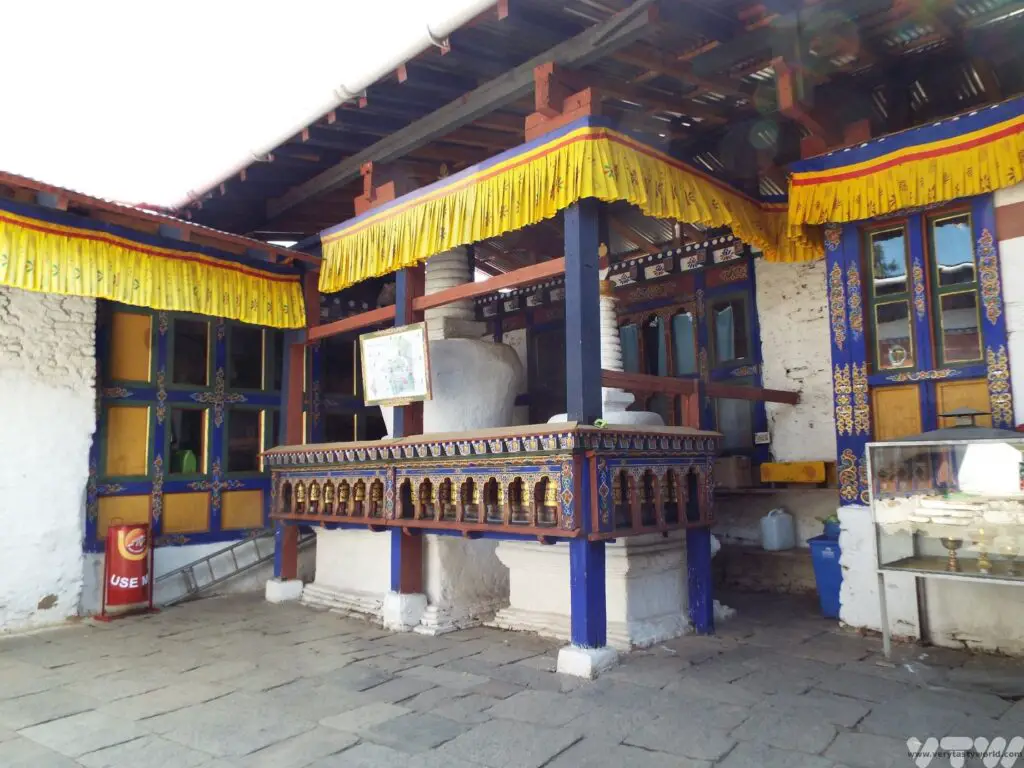
It has two orange trees in the courtyard and they are purported to bear fruit at all times of the year. There were certainly plenty of oranges on the trees when we visited.
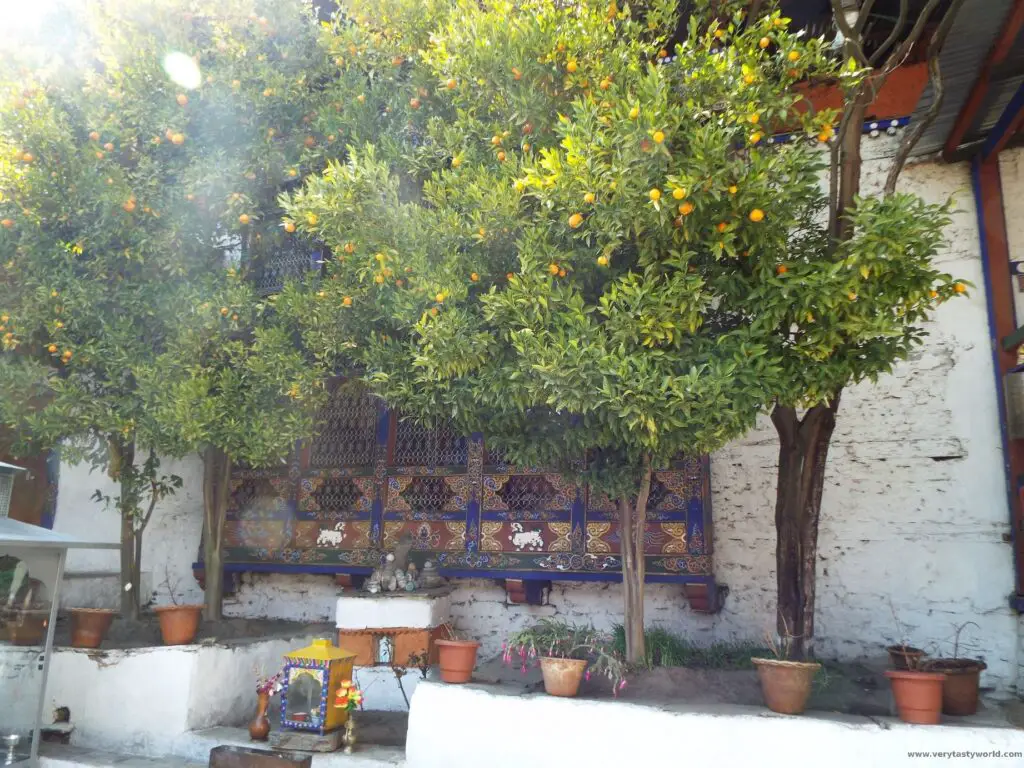
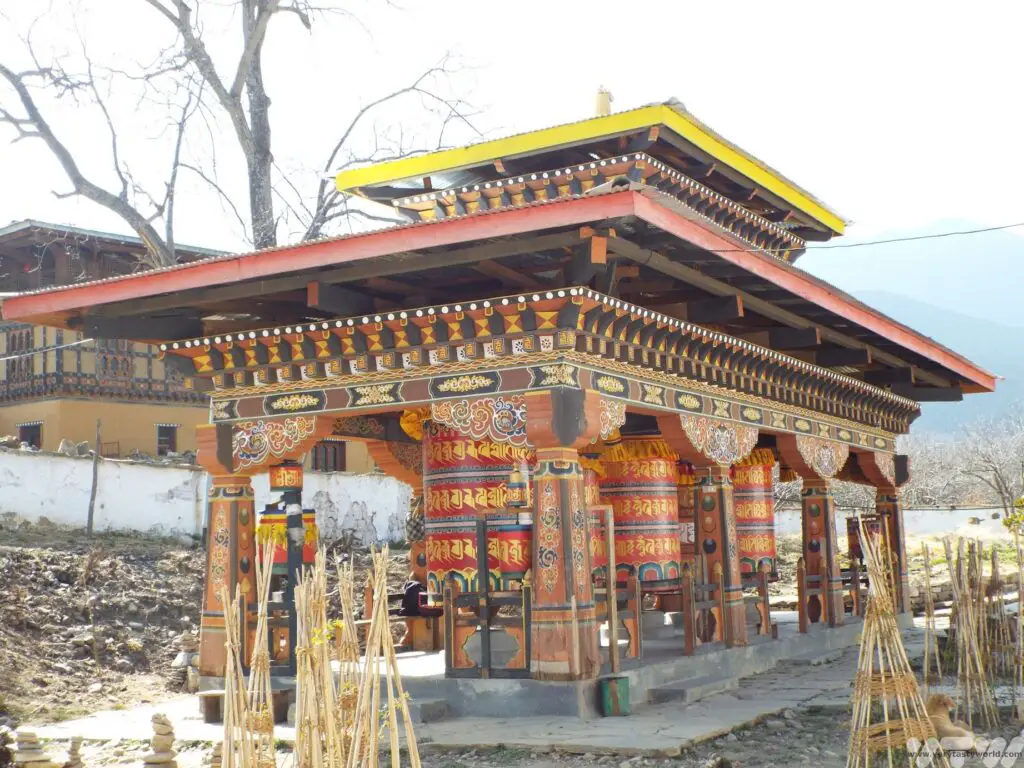
We also enjoyed trying our hands at archery, Bhutan’s national sport. There are practice ranges all over the country and it’s fine to show up and have a go. We had watched a remarkable archery tournament a few days previously – where local archers would compete to hit a tiny target from an incredible distance.
Well, it was great fun but we were fairly useless. Mitch’s first arrow flew over the fence and into the car park – fortunately, there was no one there!
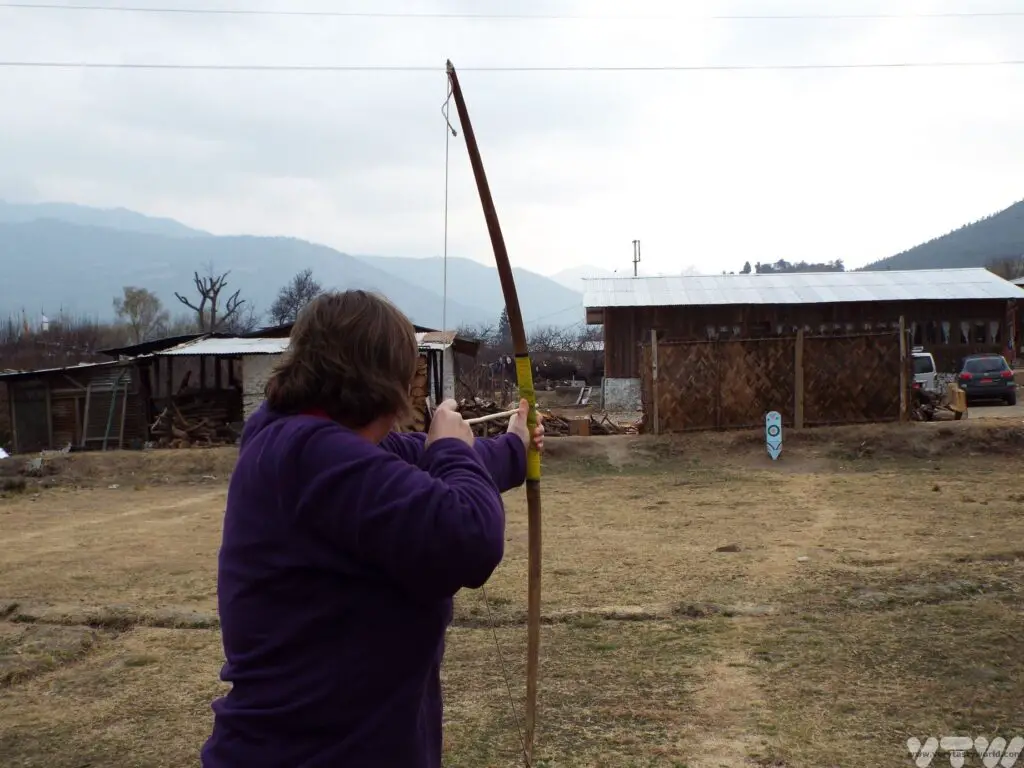
Colin did, however, eventually manage to hit the target!
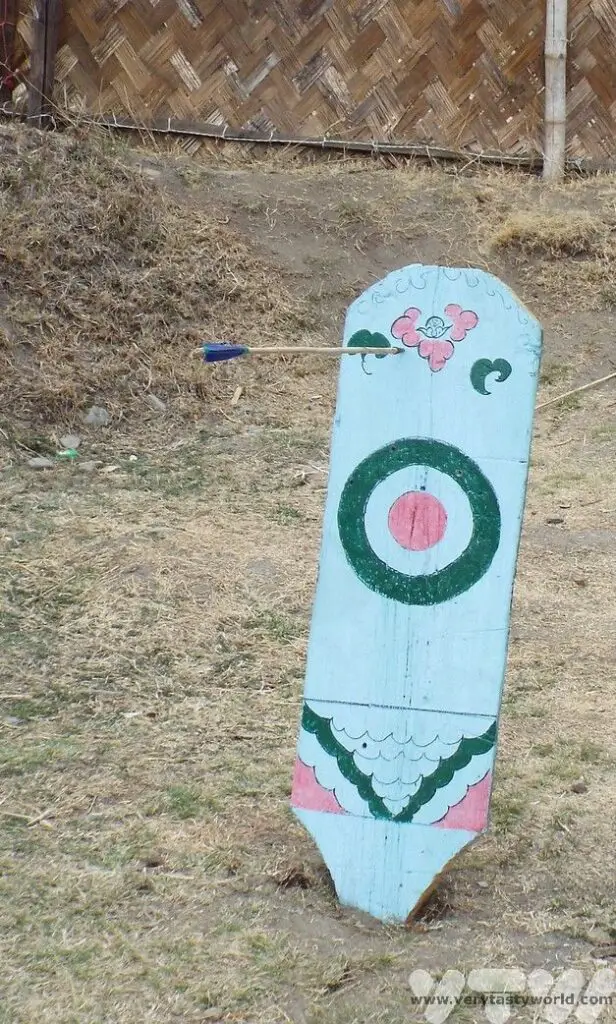
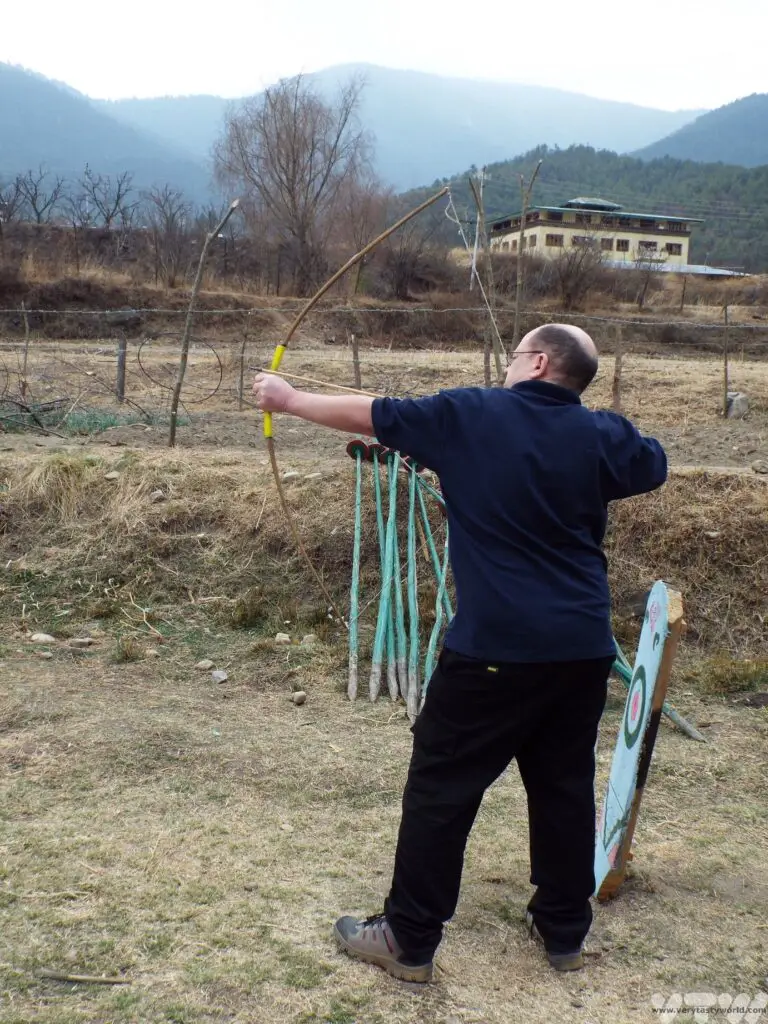
As with all things in Bhutan, if you want to try a particular activity or visit a particular site, ask your guide and they should be able to arrange it.
We stayed at the Metta Resort on the outskirts of Paro. It was a nice enough place but we found that the food was largely aimed at tourists – both Eastern and Western. We asked our guide whether we could eat at a local restaurant instead of at the hotel, so he took us to a fabulous farmhouse in the evening and we enjoyed traditional Bhutanese fare washed down with ara, an alcoholic drink made from fermented grains.
Essential Information About Visiting Bhutan
The Bhutanese government sets a daily tariff for visitors. When we visited this was $200 per day (low season) which included the costs for our delightful guide and driver, as well as all accommodation, food and entrance to the dzongs and museums. This cost included $65 for a sustainable development fee which went directly to supporting local people. So entrance to the Tiger’s Nest, and all other monasteries/dzongs, was included.
In 2022 Bhutan significantly increased the daily tariff from very expensive to even more expensive by increasing the sustainable development fee to an eye-watering $200 per day (on top of other costs). This resulted in a significant drop in visitor numbers, so the system changed again in 2023. The sustainable development fee has been halved to $100 per day (which is still expensive and doesn’t include accommodation and transportation etc) for the next four years (as at September 2023). So, if you’re planning to visit, it’s worth considering making the journey sooner rather than later. Bhutan is expensive to visit but we feel very much that our time spent in this remarkable kingdom was absolutely worth it.
Related Posts You May Enjoy

- A One Day Hanoi Itinerary
- Mekong Meanderings
- A Chiang Rai Temple and A Country Retreat
- A Chiang Mai Tour in Northern Thailand
- Sunrise at Angkor Wat and Other Temples
- Mekong Delta River Cruise in Vietnam

A Visit to Bhutan’s Punakha Dzong
Punakha Dzong is both the second oldest and second largest dzong in Bhutan and is of huge historic and cultural importance to the Bhutanese people. It was the site of the former capital of Bhutan before the administrative centre moved to Thimphu in 1955. It is the location for one of the many festivals in Bhutan that are held throughout the year.
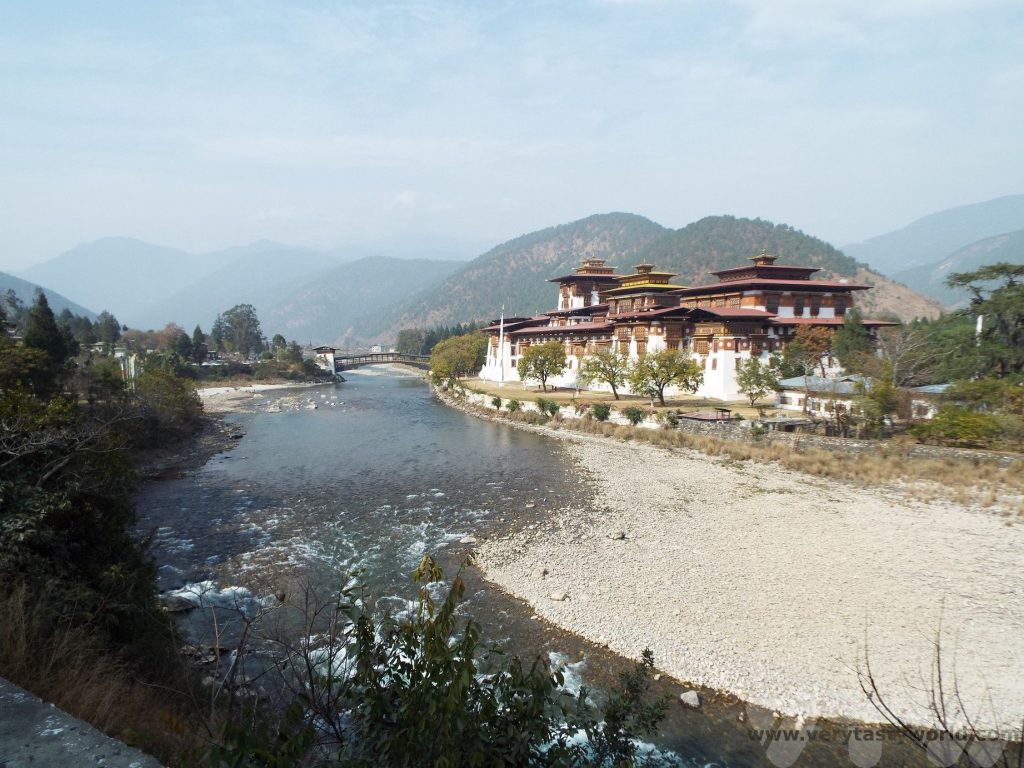
Getting to Punakha
When travelling in Bhutan independent travel is not encouraged and the government set a minimum daily price for visitors. When we visited there was a high season and low season and prices varied accordingly. The costs included transportation, accommodation, a driver and guide, and meals. Some of the money raised is used by the government as part of a sustainable development fund for education and healthcare for the Bhutanese people.
However, since Bhutan opened up following the pandemic, the minimum price has increased significantly, and the tourism fee is charged on top of the travelling expenses.
We were shown this amazing country by our delightful guide Dawa and driver-extraordinaire Tring. Punakha is located east of Bhutan’s capital and it takes around three hours to drive from Thimphu.
One thing that you get used to about driving through Bhutan is that the roads are rarely straight – they will wind their way up the mountain passes through multiple hairpin bends and then wind their way down. It’s a lovely way to travel although we were told that some visitors can occasionally suffer a degree of travel sickness.
On the way we crossed the Dochula Pass, at an altitude of 3100m, which offered wonderful views of the surrounding mountains.
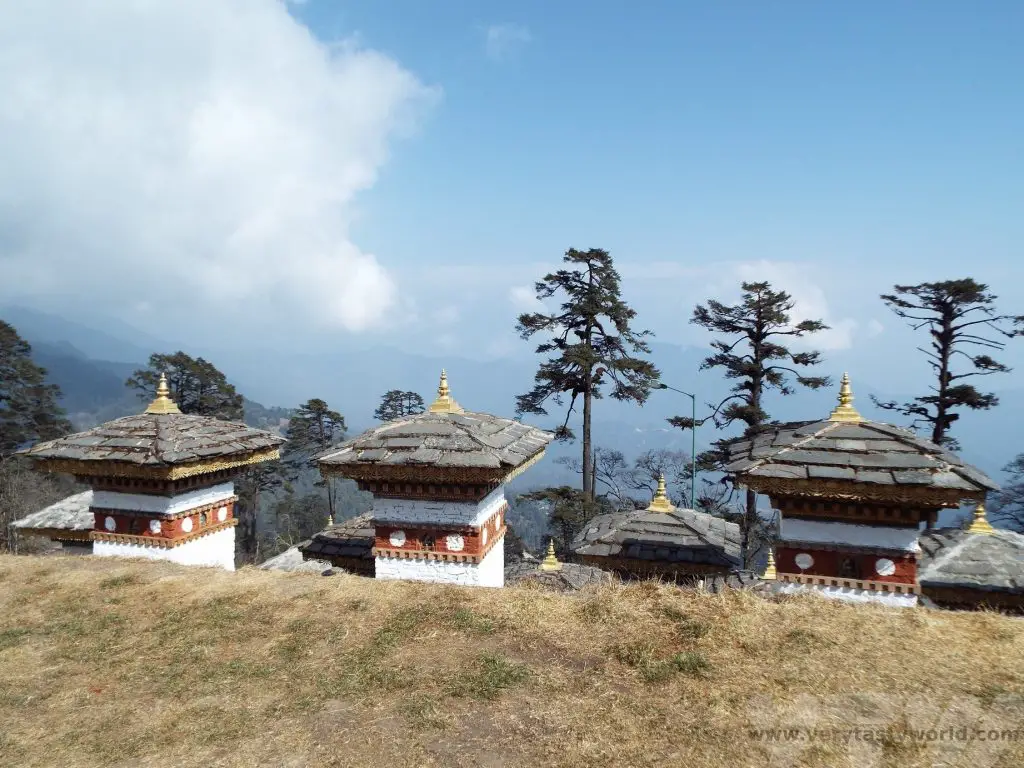
The pass is noted for the 108 Druk Wangyal Khang Zhang Chortens (also known as stupas) which are located on a hill beside the road. They are a memorial to Bhutanese soldiers killed in a battle between Bhutan and Assam insurgents in 2003.
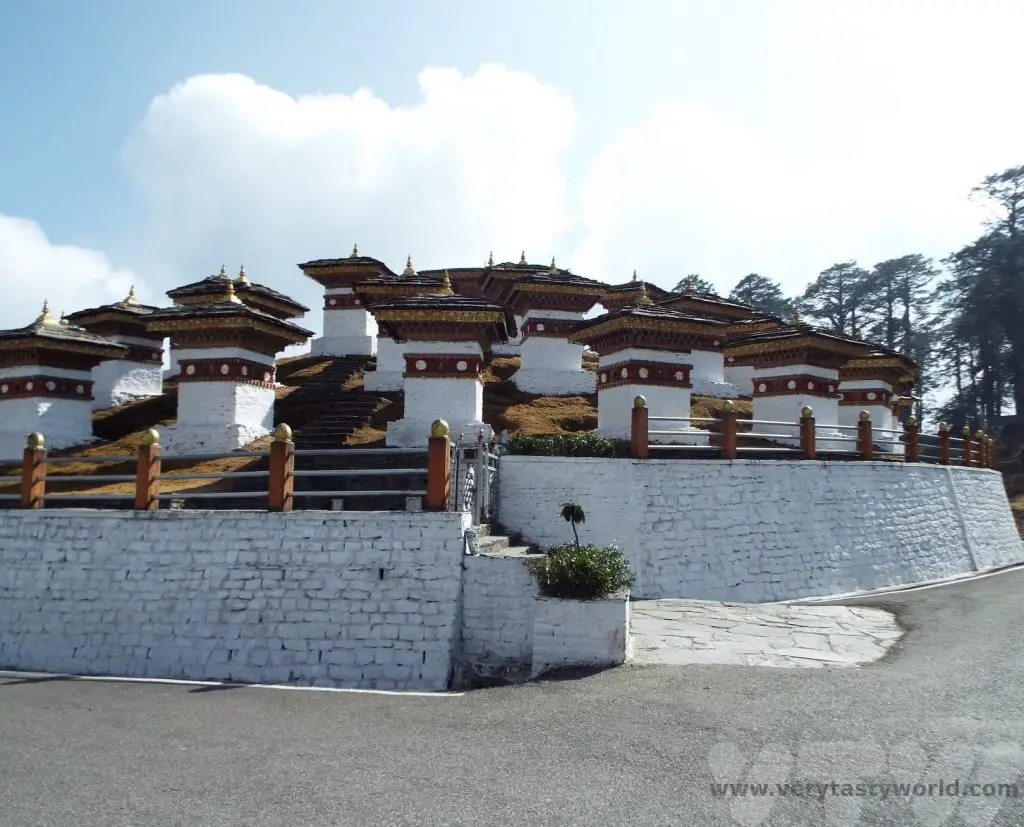
Visiting Punakha Dzong
Punakha Dzong is located at the confluence of the crystal-clear Pho Chu and Mo Chu rivers, respectively the male and female rivers, which join to form the Puna Tsang chu or Sankosh river. A dzong is a fortified monastery and its architecture is typical of this region.
One of the lovely things about Bhutan is that the country has a happiness index, created by the 4th King of Bhutan, who declared that ‘Gross National Happiness is more important than Gross Domestic Product.’ He was absolutely right. Punakha Dzong has another name: Pungthang Dewa chhenbi Phodrang which means ‘palace of great happiness’.
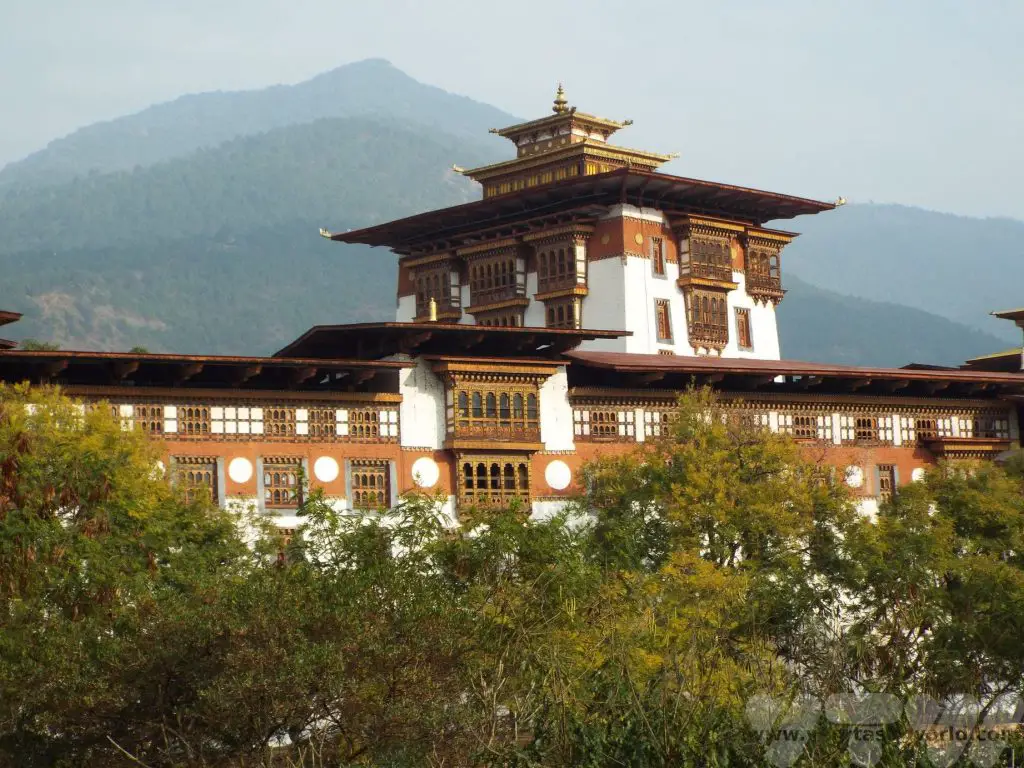
The dzhong was built in 1637-38, conceived by Ngawang Namgyal, 1st Zhabdrung Rinpoche, the Buddhist lama who unified Bhutan as a nation state. There is a legend that the architect had a vision, inspired by Zhabdrung, which encouraged him to design and construct the building.
The main central tower, the utse, is a hugely impressive piece of architecture. It is a fortress as much as monastery and as such has defensive walls all around. The entrance is defined by a very steep staircase and a huge wooden door. The interior is filled with beautiful murals depicting the life of Buddha as well as three large gilded statues – of the Buddha, Ngawang Namgyal and Guru Rinpoche, the most important saint in Bhutan, credited with bringing Buddhism to the country. He is also known as Padmasambhava, which means ‘born from lotus flower.’
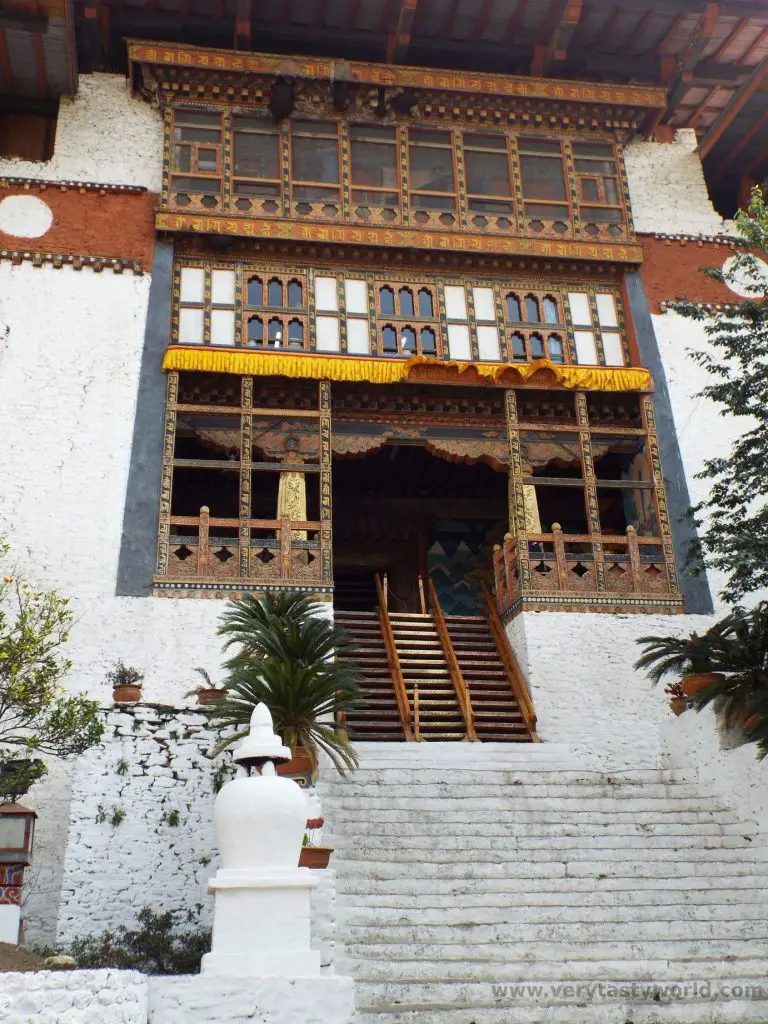
There are three courtyards within the dzhong, known as dochey. and these are surrounded by administrative offices and a bodhi tree, a sacred fig, which is hugely revered in Buddhism.
The last courtyard is home to the Nag Yul Bum Temple. National treasures such as the embalmed body of Zhabdrung and the original Kanjur, the holy book, are stored here. No one is allowed to enter besides the king and the chief abbot.
The dzhong also has a covered wooden bridge which crosses the clear blue waters of the Mo Chu. The original bridge was built in the 17th century but was destroyed during a flash flood in the 1950s. A replacement was completed in 2008.
When visiting monasteries in Bhutan conservative dress should be worn. We were advised that we should wear long sleeves when entering temples. If the weather is warm it’s fine to put on a light jacket (we used our light raincoats). Also, photography is usually forbidden inside temples and it’s important to respect this.
Punakha Festival and the King’s Birthday
Each year the Punakha festival is held in February or March, depending on Bhutan’s lunar calendar. It lasts five days. There are all sorts of displays throughout the festival. Punakha Drubchen celebrates the Bhutanese victory of the Tibetans, who invaded of Bhutan in 1639, with dramatisations and re-enactments of the battle. In 2005, Punakha Tshechu was introduced and this focuses on traditional Buddhist teachings. Folk dancing is an important part of the festivals. Everyone dresses up in their finest traditional clothes. Men wear a gho, a knee-length tunic and women wear a long ankle-length dress called a kira.
We just missed the festival dates but were lucky that the timing of our visit enabled us to join the festivities for the king’s birthday, a three day celebration for Jigme Khesar Namgyel Wangchuck, the fifth and current Druk Gyalpo. (We were doubly lucky because we later travelled into Nepal, where we joined in celebrations for the Hindu festival of Holi.) Even though we had arrived quite early, the festival was well under way. There was plenty of dancing…
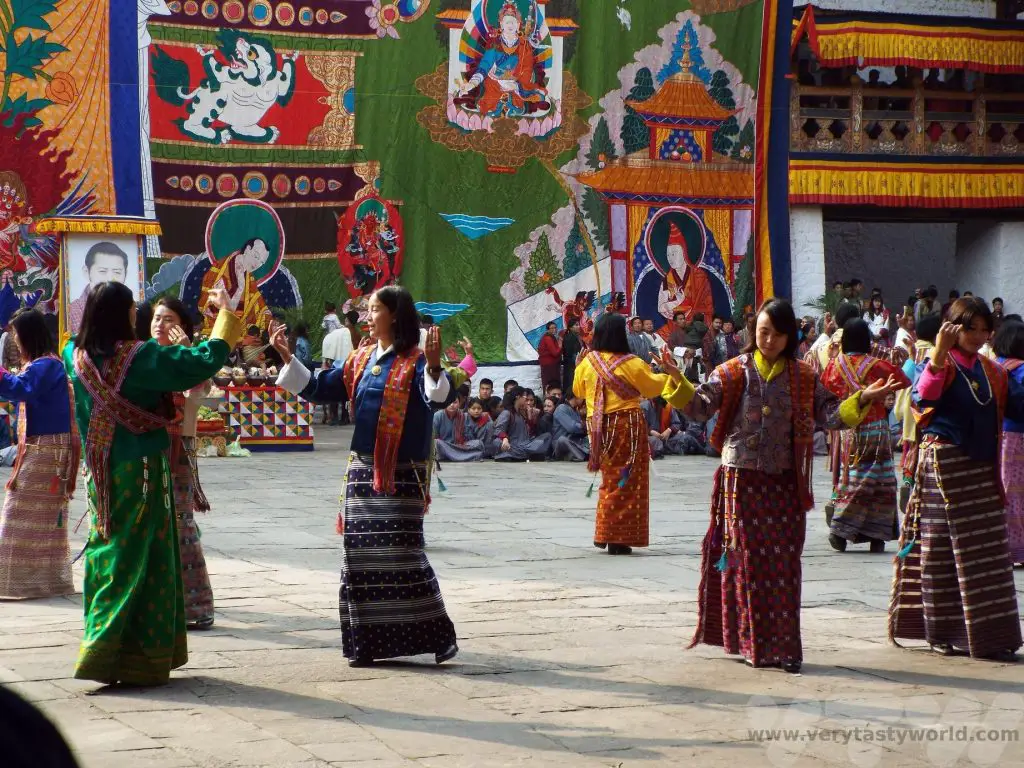
…formal…
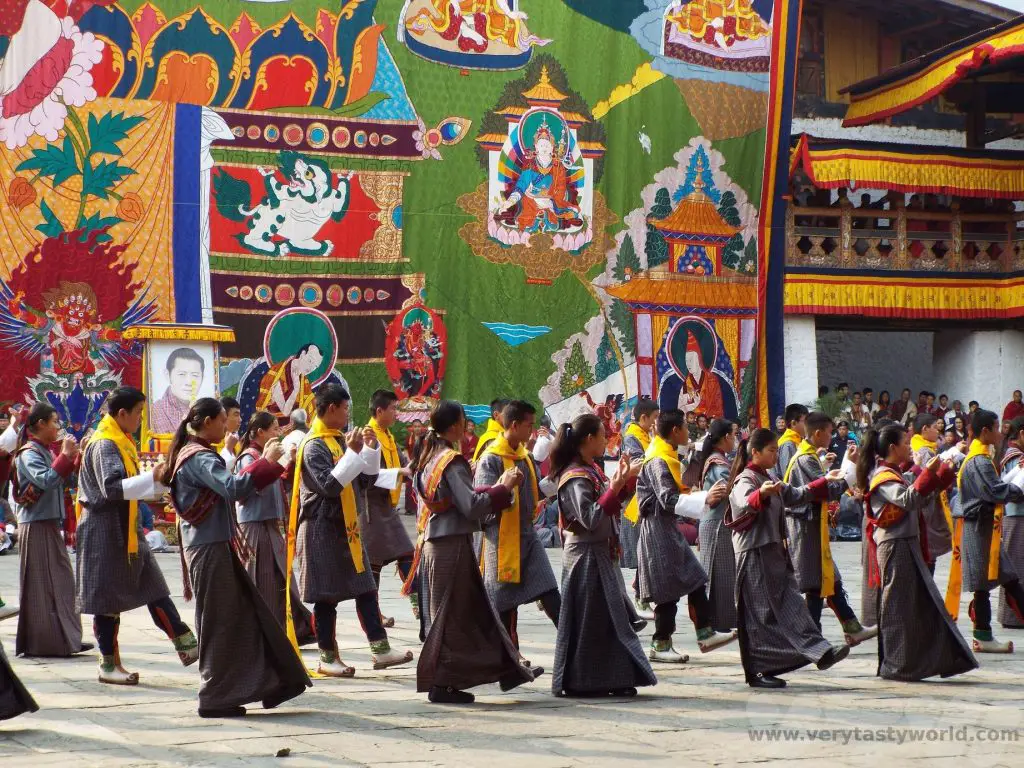
… and informal.
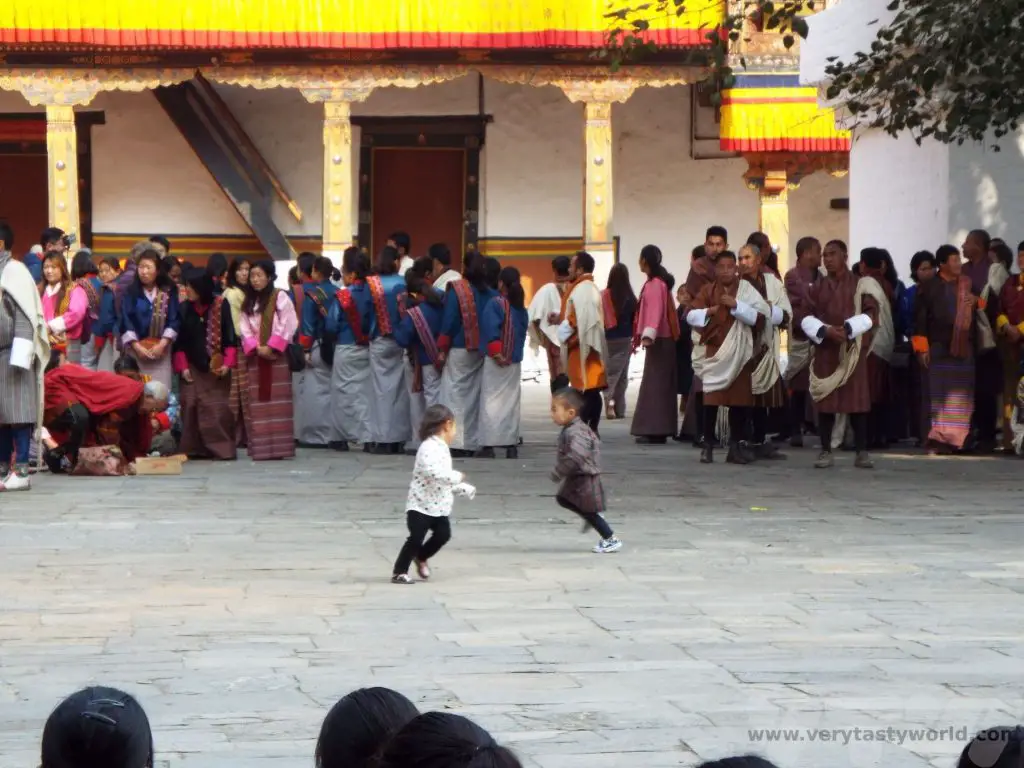
We watched the dancing from underneath the bodhi tree. As part of the celebration an enormous tapestry, known as a thongdrol, is unfurled. It is the most beautiful and colourful tapestry, taking up the side of a whole building within the complex. You can see a portrait of the king at the base of the tapestry. Respect for the king is enormous in Bhutan and his image can be found in most people’s homes.
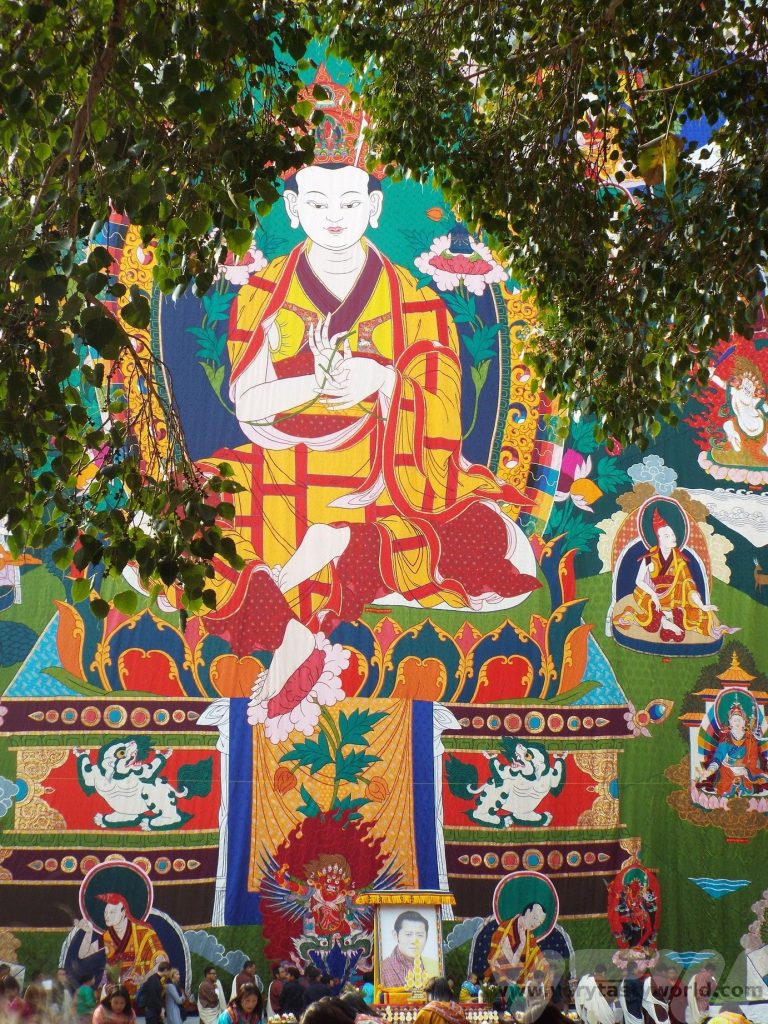
Inside the temple complex there were further celebrations with masked dances performed by the monks.
Above all else, it was a happy festival. Everybody welcomed us. We got chatting to some of the local ladies – they were very keen to practice their English (which was excellent) and we talked about the traditions in our countries.
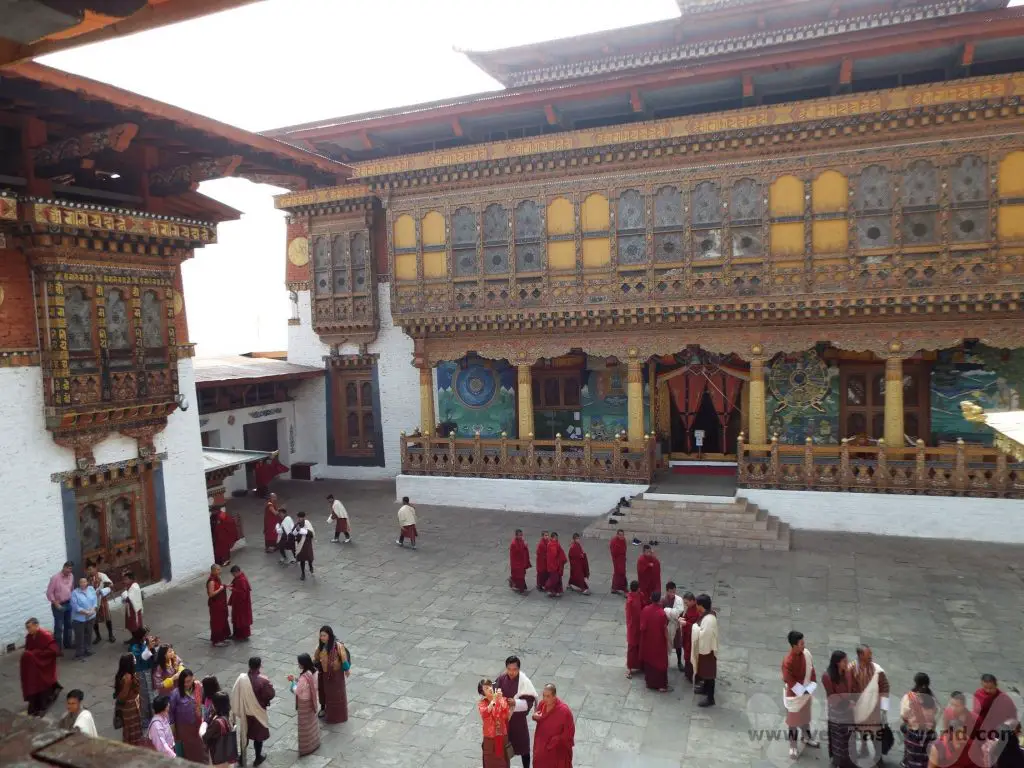
Other Things to See in the Area
Exploring the Rivers and Suspension Bridge
This is the longest suspension bridge in Bhutan and it crosses the Po Chu river, linking the Dzong to Shengana, Samdingkha, and Wangkha.
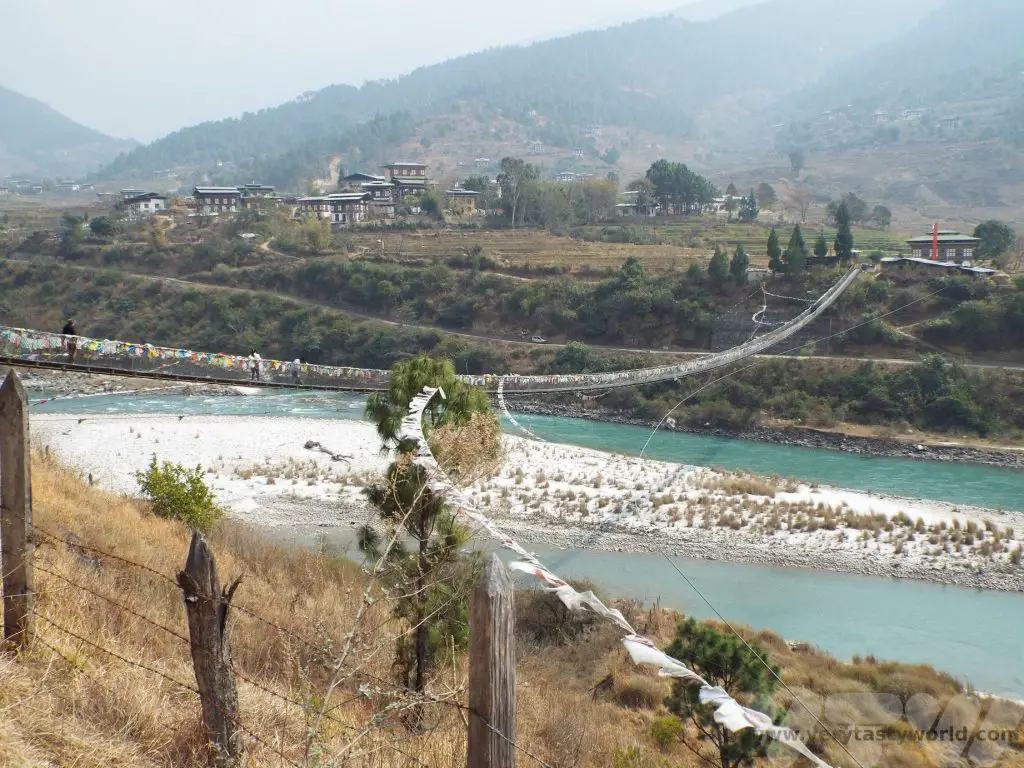
It’s 160m long and is emblazoned with prayer flags that wave vigorously in the breeze.
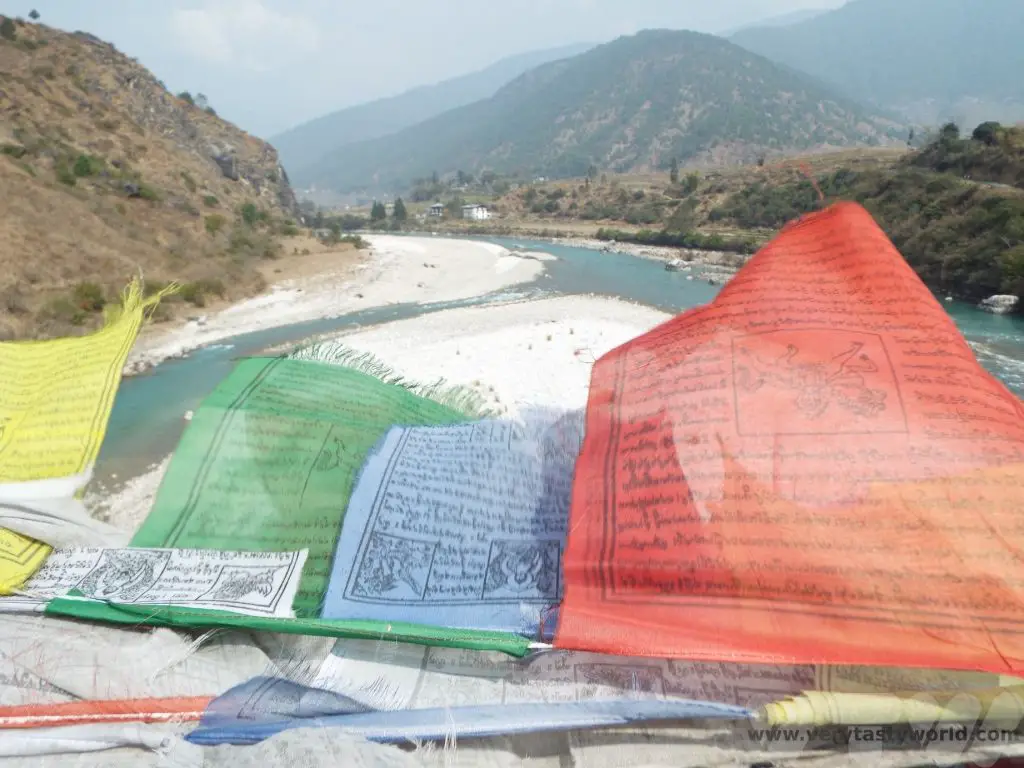
There are some good walks along the Mo Chu river upstream. It’s a really beautiful area. And, if you’re feeling adventurous, there may also be some opportunities to go rafting on the river.
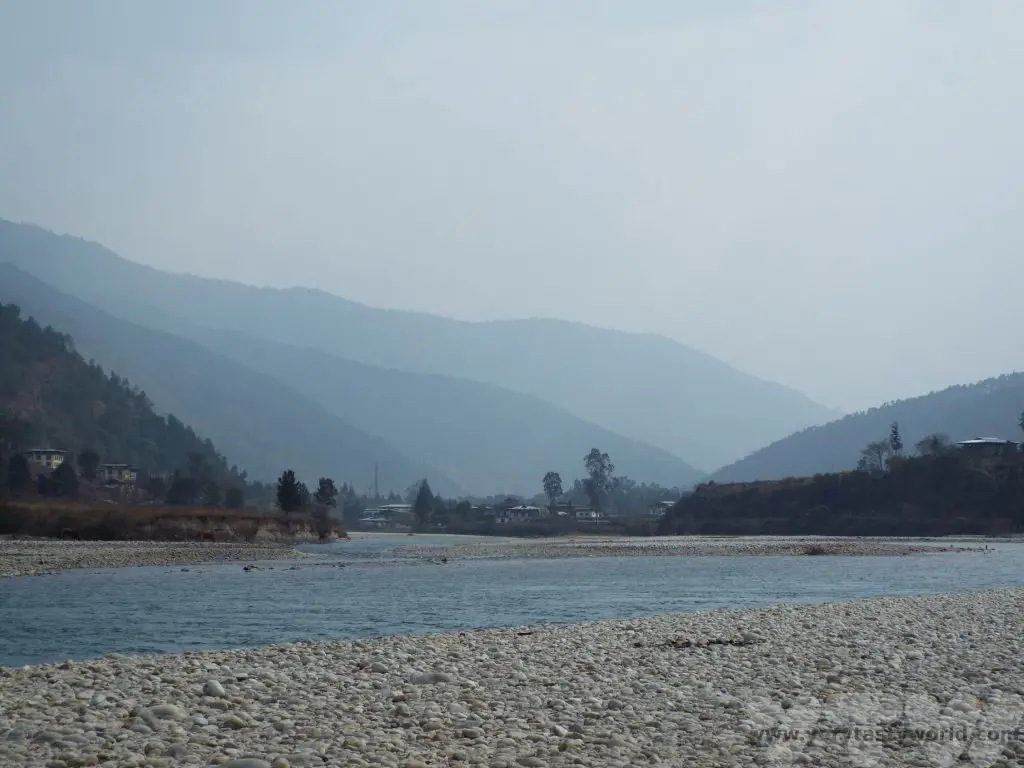
Sangchhen Dorji Lhuendrup
The Sangchhen Dorji Lhuendrup nunnery is located in Wolakha. It provides a permanent training and meditation centre for nuns. There are also opportunities for the nuns to learn various skills such as tailoring, statue making and thangka painting (a traditional style of Buddhist painting).
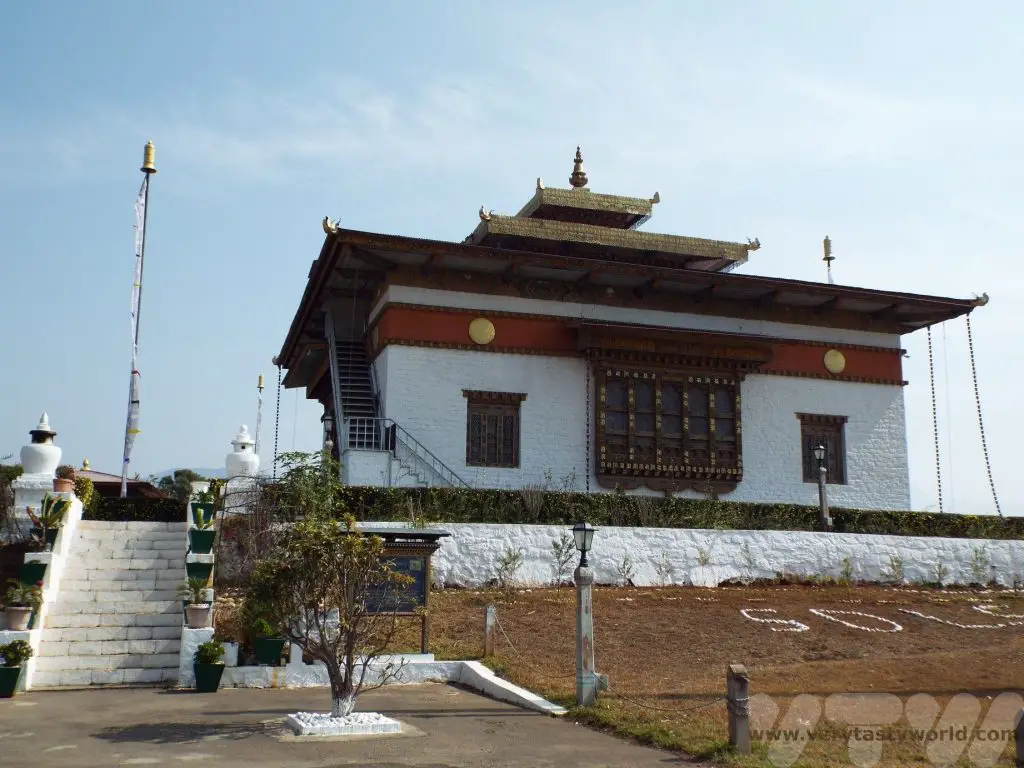
The temple has an impressive stupa.
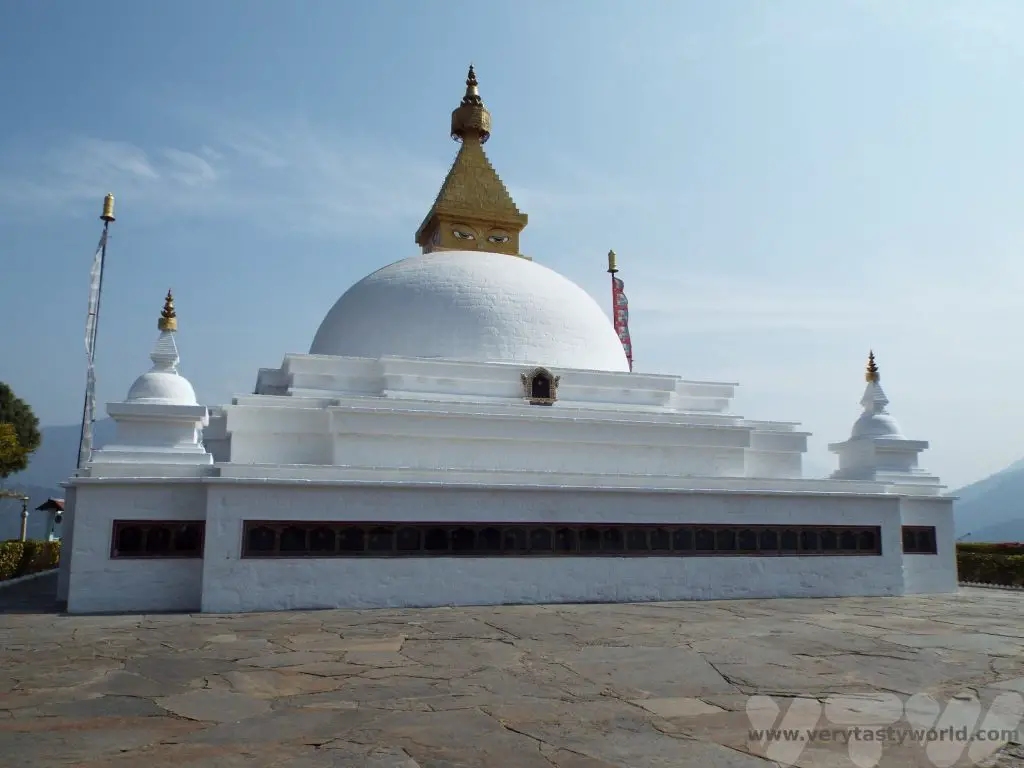
Chimi Lhakhang
Chimi Lhakhang is located around 10km from Punakha. It is a monastery built in the 15th century after being blessed by Lama Drukpa Kunley, also known as the ‘Divine Madman’, who had an, er, unusual approach to teaching Buddhism which often involved singing, dancing and generally being shocking. He brought from Tibet a wooden phallus adorned with a silver handle and this is housed in the monastery.
It is used to strike pilgrims, particularly women who wish to become pregnant, on the head as a blessing.
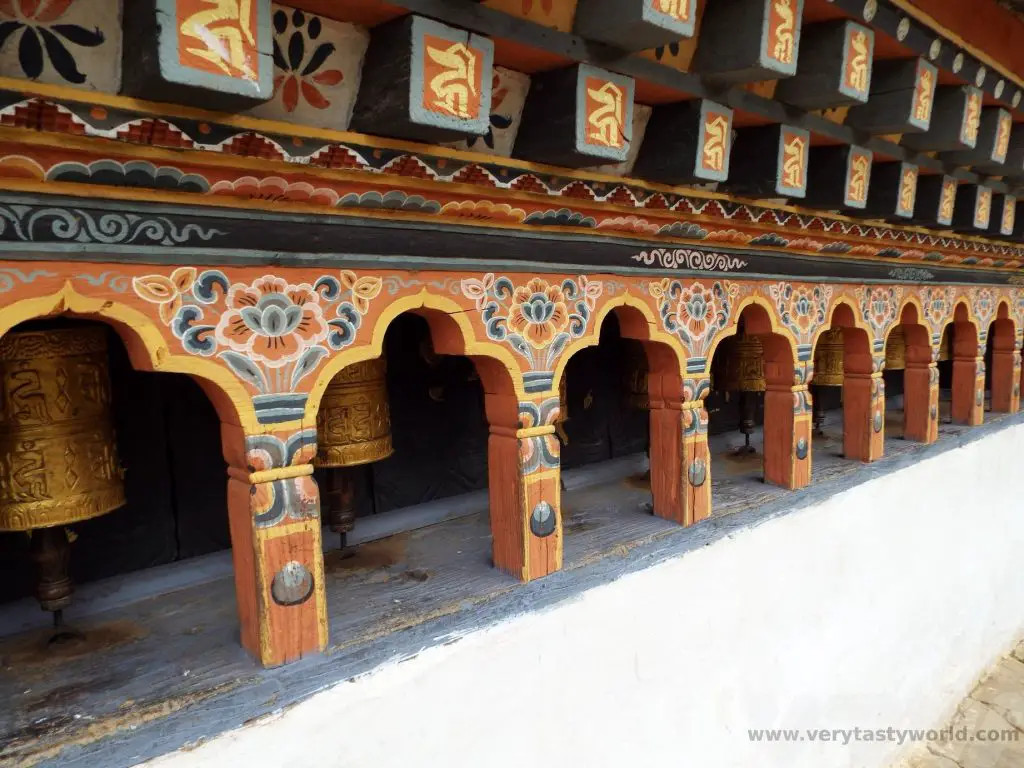
All through the area you will see paintings of phalluses on housing walls. It is a tradition in Bhutan that the phallus protects people from evil.
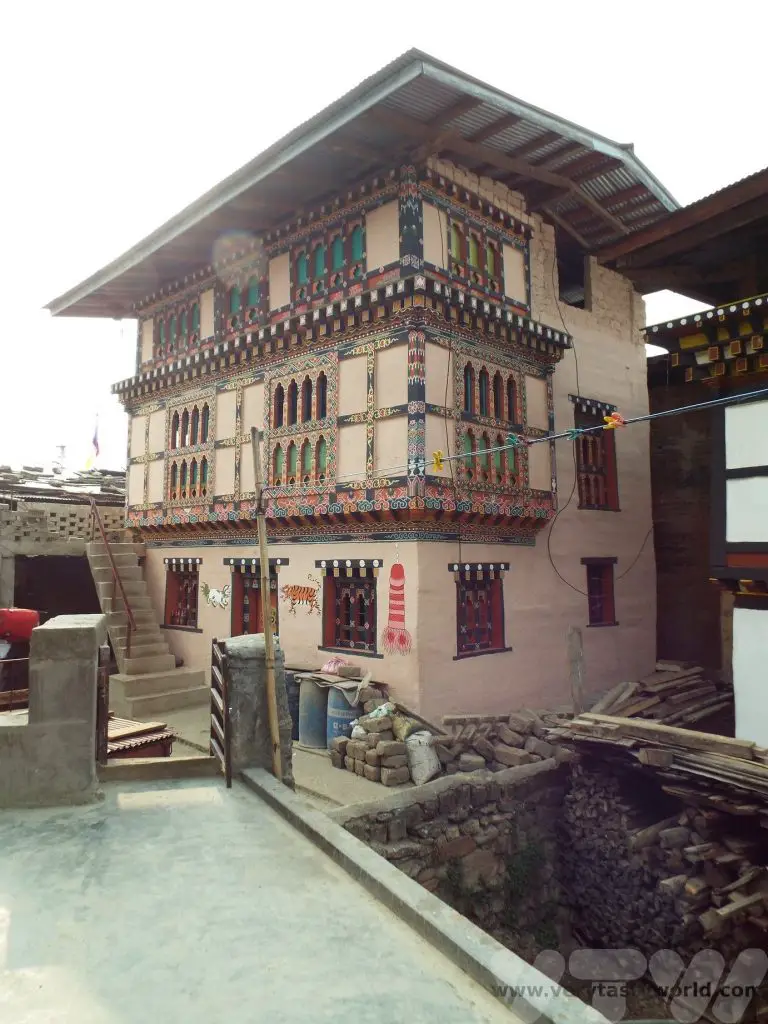
Staying At A Local Farmhouse
We spent the night in Chimi Lhakhang Farm – we had a cosy attic room and cooked dinner with our lovely hosts.
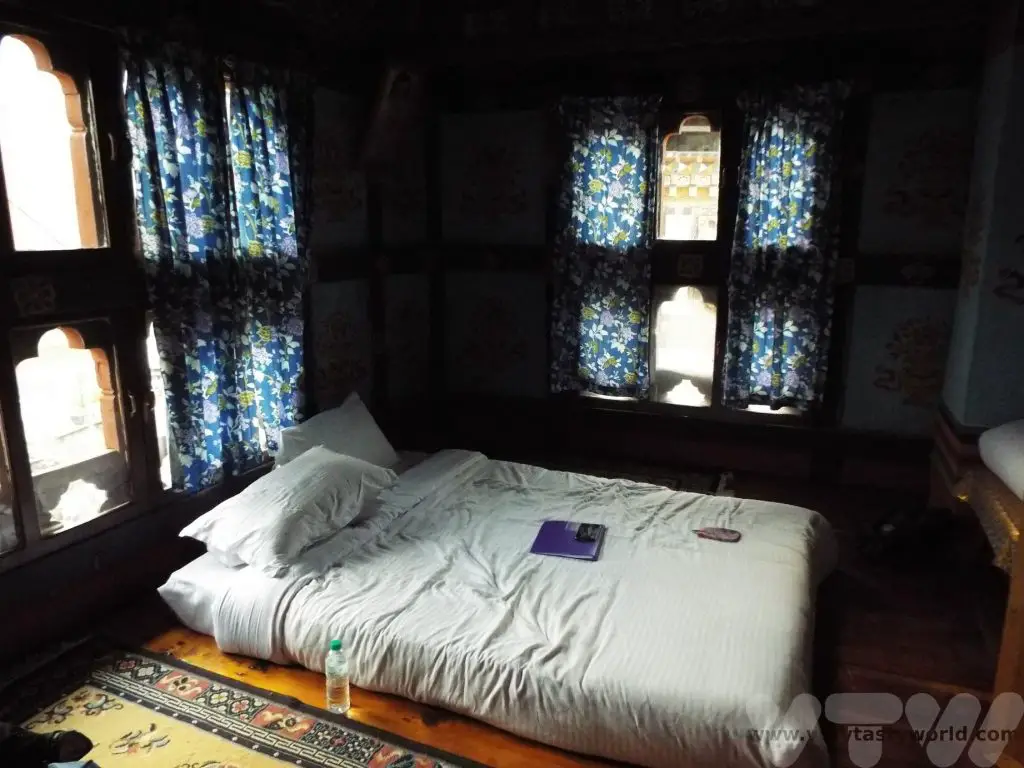
Our guide often asked what sort of food we would like to try – of course we asked if we could enjoy traditional Bhutanese food.
We had great fun in the evening and spent time in the kitchen preparing dinner with our hosts. Dawa and Tring joined in with the cooking as well.
The main dish was shakam paa, which comprised dried beef cooked with chillies and radish slices, spiced with dried chillies.
We also learned how to make khewa datshi, a dish of sliced potatoes with cheese.
And, of couse, the ubiquitous and utterly delicious ema datshi – chilli cheese.
All served up with red rice, it was a feast!
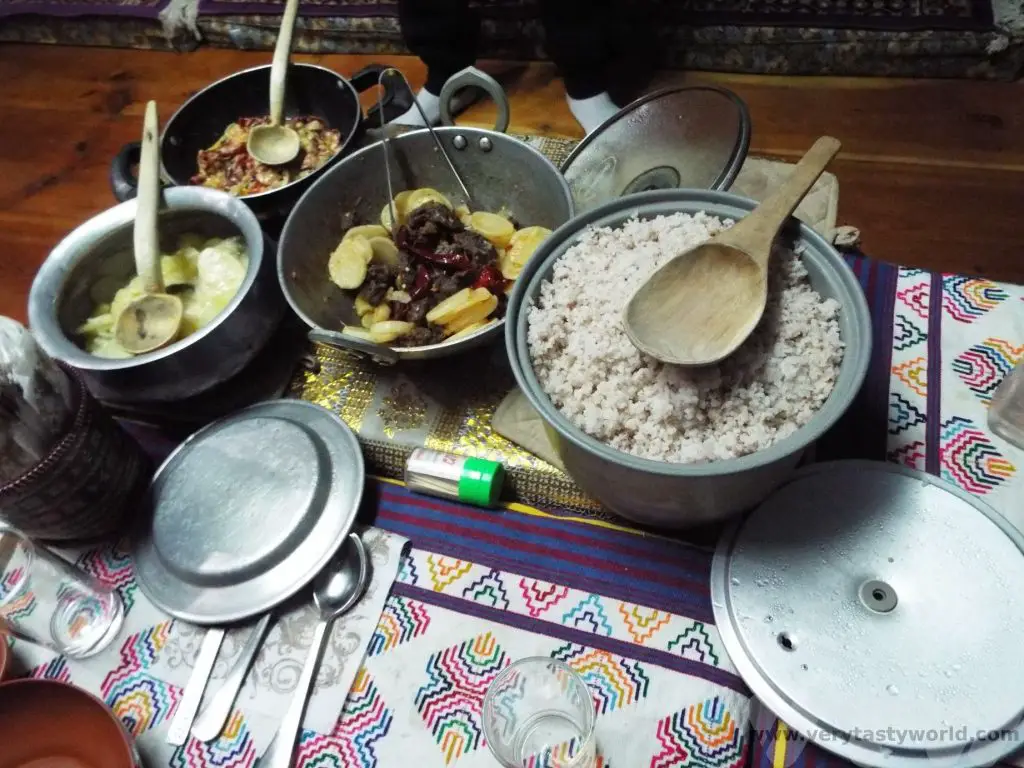
Related Posts You May Enjoy

- A One Day Hanoi Itinerary
- Mekong Meanderings
- A Chiang Rai Temple and A Country Retreat
- A Chiang Mai Tour in Northern Thailand
- Sunrise at Angkor Wat and Other Temples
- Mekong Delta River Cruise in Vietnam

Bhutan Chilli Cheese
The tiny mountain kingdom of Bhutan is more famous for its amazing landscapes, beautiful dzong (monasteries), trekking possibilities and the fact that its king uses a gross national happiness index to understand the well-being of his subjects than its cuisine. The country has a national dish that is unexpected and delicious. And really, really spicy: Bhutan chilli cheese.
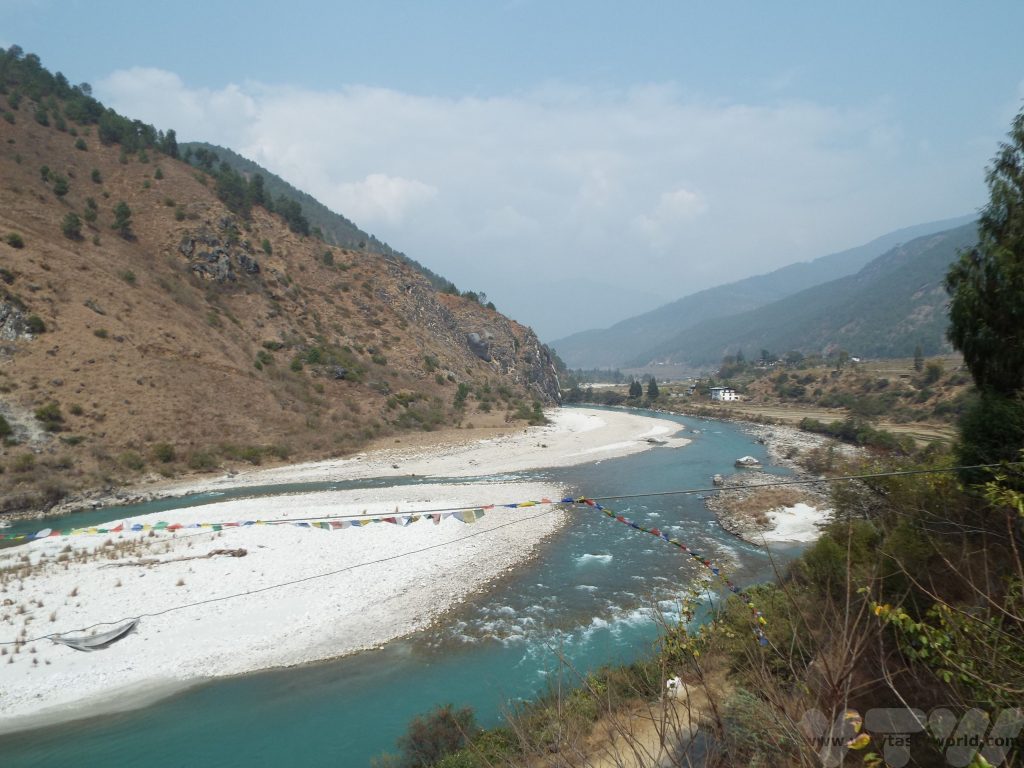
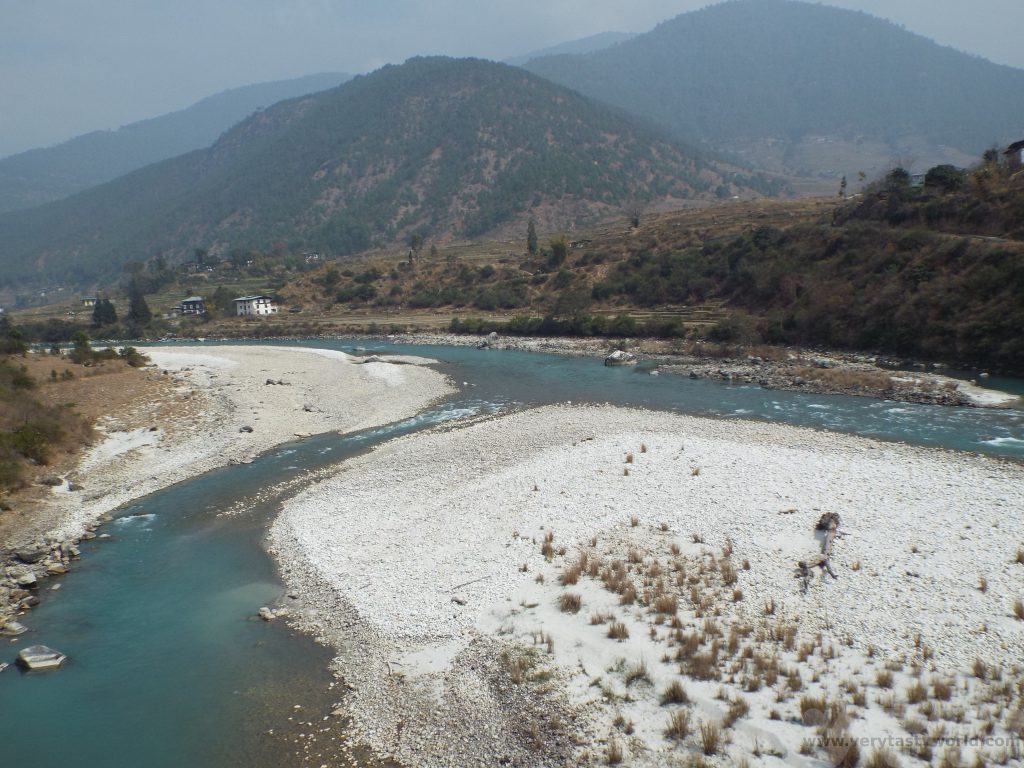
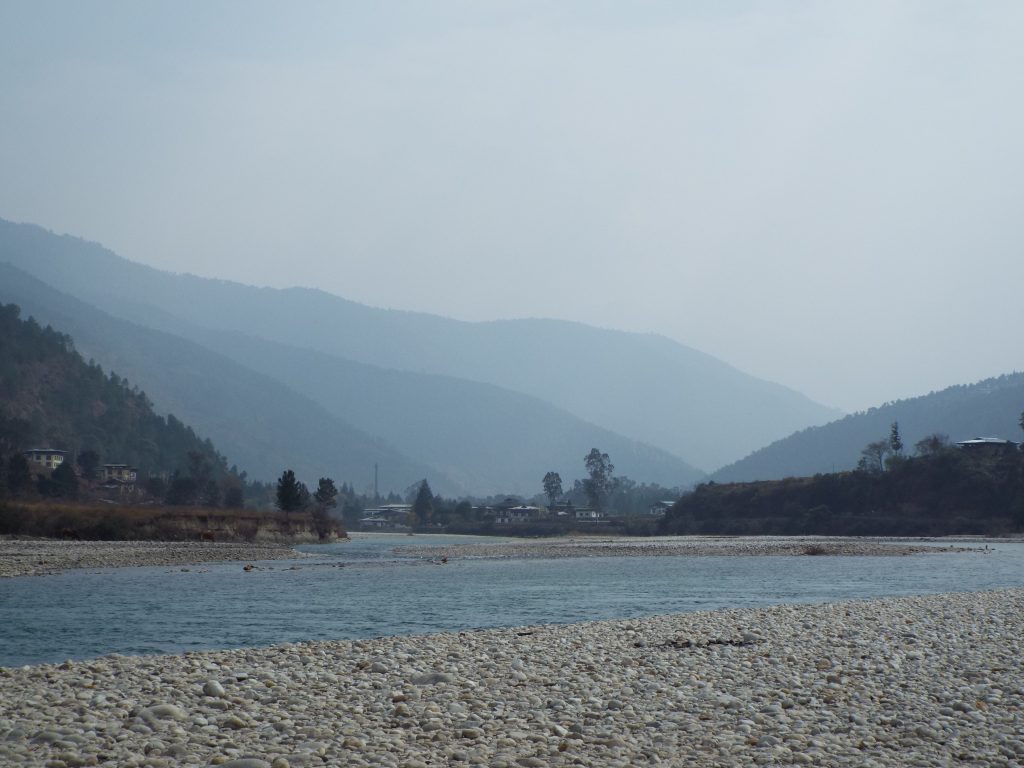
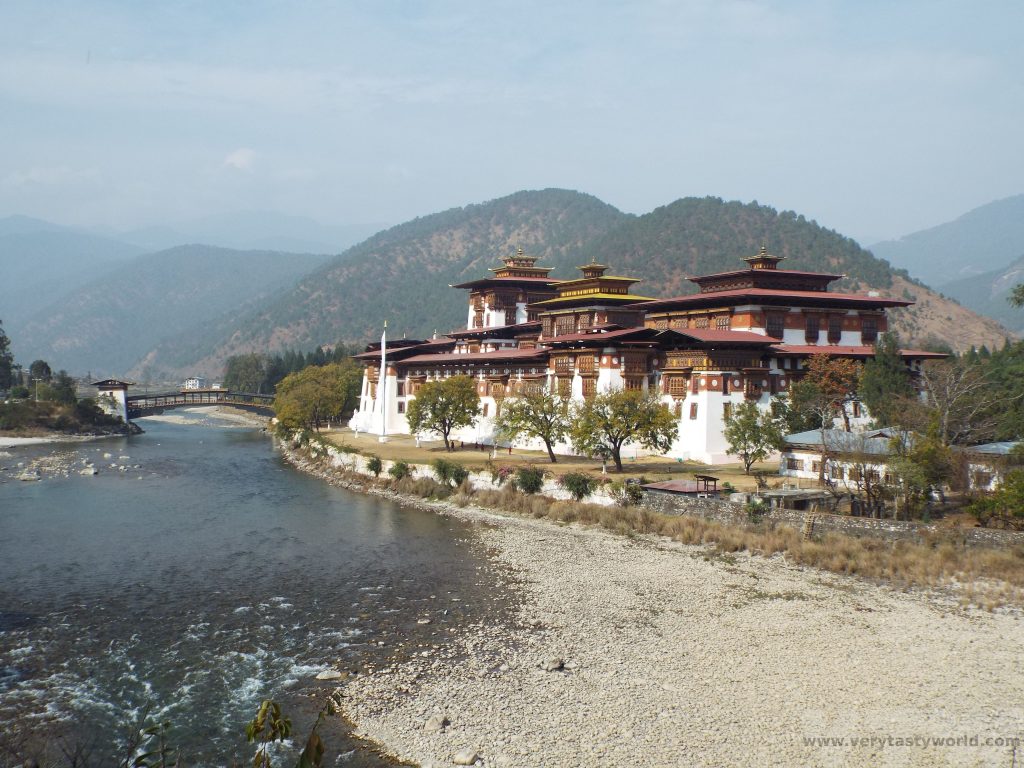
In Bhutan, chillies aren’t so much considered to be condiments – something to liven up a meal – but rather are used as vegetables. A meal isn’t considered to be complete if it doesn’t contain chilli. The country’s national dish is ema datshi: ema meaning “chilli” and datshi meaning “cheese”: Bhutan chilli cheese! The sorts of chillies the Bhutanese use are large, red chillies. Normally larger chillies are less hot than the teenie, weenie fiery ones but these still pack a punch. The chillies may be dried and can be rehydrated simply by cooking gently in water.
You can often see chillies drying in the sunshine outside houses.
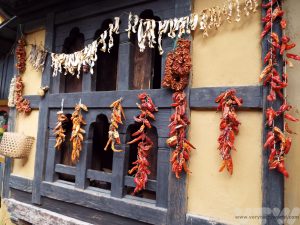
Chilli and cheese as a combination actually makes perfect sense. The heat of the chilli is stored in the seeds and the membrane on the inside of the fruit, capasaicin being the active ingredient, which sticks to the tongue and provides that essential – and addictive – burn. There’s an old saying that you should never drink water to quench the heat of a chilli – it’s like mixing oil and water, it just doesn’t work. But milk contains casein which acts like a detergent, binding to the capasaicin and allowing it to wash away, providing a calming effect.
Take this one step further to blend chilli with cheese and you have a gorgeous conglomeration of fire and calm. And, in Bhutan, to be enjoyed with every meal.
Making Bhutan Chilli Cheese
We were lucky enough to learn to make chilli cheese when we stayed on a farm in the lovely Punakha region.
The datshi of ema datshi is a cheese made from cow or yak’s milk, a soft-ish cheese with a texture that was reminiscent of ricotta. It has a salty, tangy flavour.
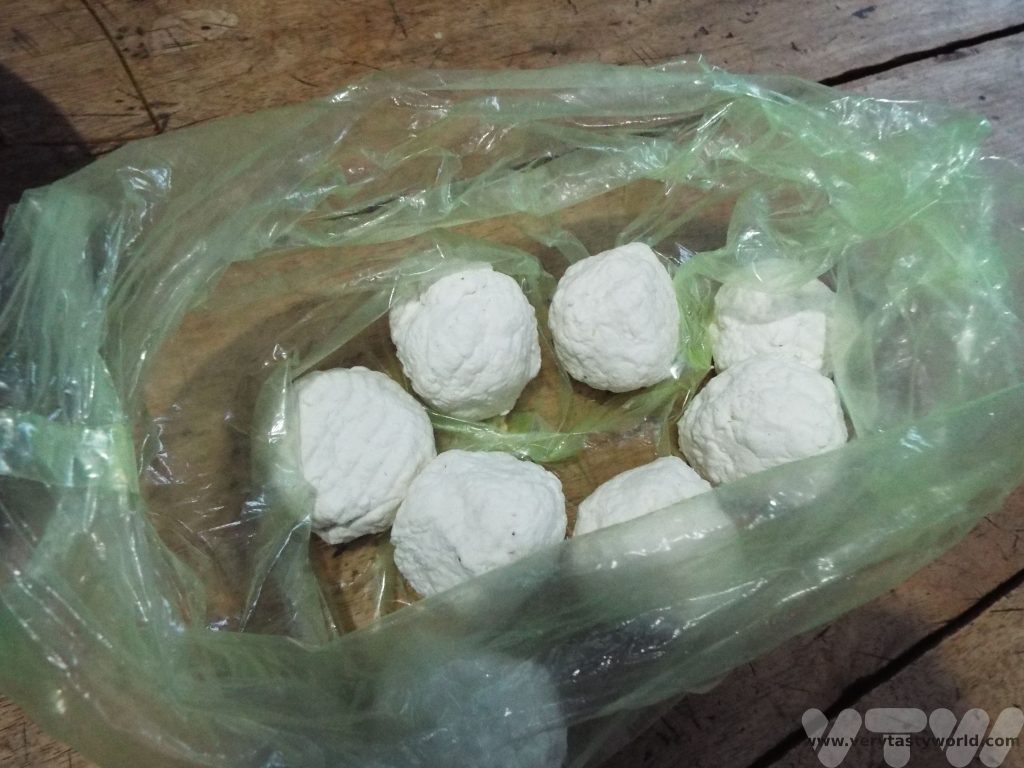
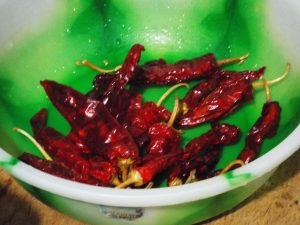
The chillies are often dried and need to be rehydrated. They are added to a saucepan with a small amount of water and salt for seasoning. They are then simmered until tender.
The cheese is added in slices, taken from the outside of the cheese ball, and the saucepan is taken off the stove to allow the cheese to melt in the residual heat.

The resulting Bhutan chilli cheese is undeniably fiery but utterly delicious and curiously moreish.






